Epiphanies and Misdemeanours: Matt Dennis in conversation with Alan Gouk
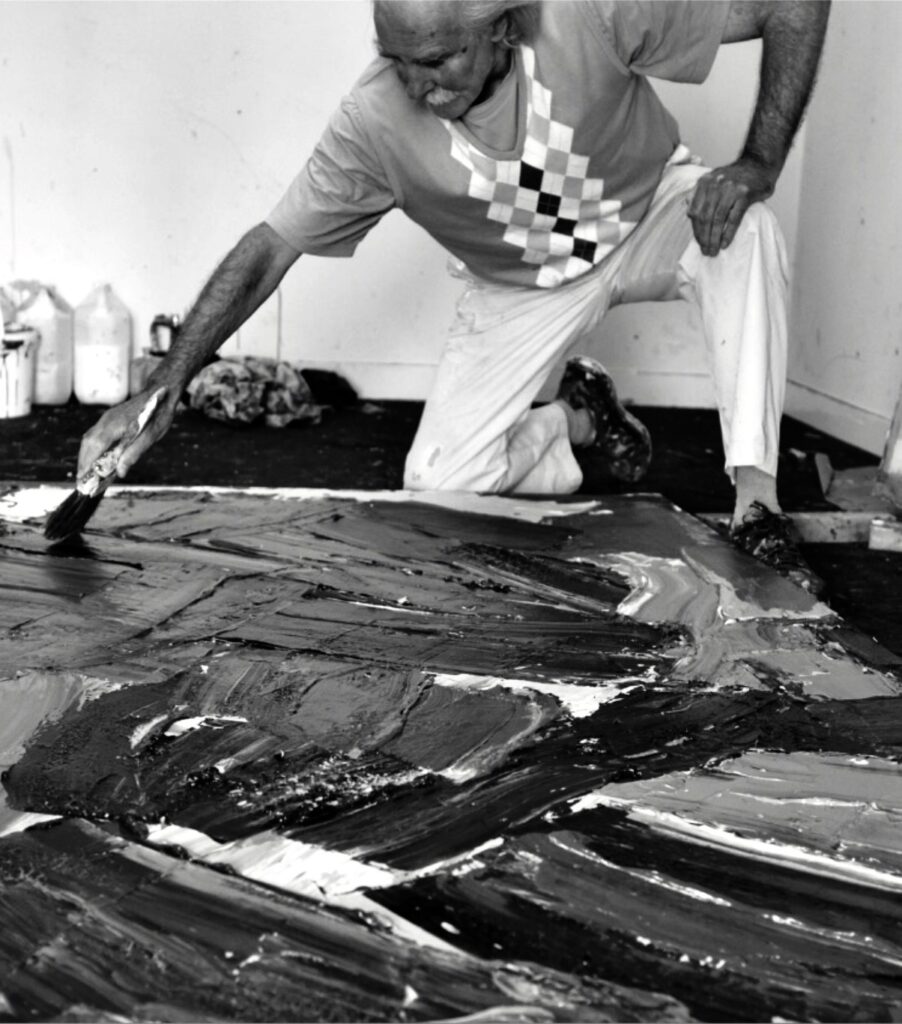
Across six decades, Alan Gouk has kept faith with abstract painting; and in working to extend and enlarge the space of abstraction first opened up by the great pioneers of modernism, he has made, and continues to make, extraordinary paintings.
And whilst any serious consideration of his lifetime’s achievement must, like this post you are now reading, begin and end with the paintings themselves, there is so much more to be taken into account: his work as Exhibitions Officer with the British Council, that brought him into contact with pretty much everyone of importance in the art establishment of the mid-1960s; his long involvement with the teaching of abstract sculpture at the very highest level, on the Advanced Course at St Martins School of Art during the ground-breaking years for British sculpture of the 1960s and 1970s; his pivotal role amongst the artists that established, maintained and worked in the studios at the Stockwell Depot, one of the very last redoubts for a certain strain of High Modernism in painting and sculpture against the onslaught of postmodern art; and of course, the writing: running parallel to his studio practice, informed by the same instincts that have impelled him always to aim high in his own painting, looking always to identify and elucidate the reasons why the work of this painter or that sculptor succeeds or falls short. In the 1970s and 1980s, the late, lamented journal ‘Artscribe’ provided the platform for much of his finest writing; and in our turn, we have been lucky enough at Instantloveland to have had the chance to commission and publish several of Alan’s recent essays, to considerable acclaim.
‘Epiphanies and Misdemeanours’, the product of a day spent interviewing Alan in his home in Ramsgate, countless follow-up email exchanges, and a handful of ‘Zoom’ meetings, does its best to hold a steady course, and to (more or less) stay inside the thematic boundaries that he and I agreed on, and a narrative movement that (more or less) takes us from the 1960s right up to the present; but it also tries to do something somewhat at odds with those aims, by allowing, and frequently encouraging, its subject to roam digressively across the span of his long involvement with what he has called ‘the succulent life of painting’, recalling the ups and downs of his friendships with (amongst others) Caro, Hoyland and Heron, and a half-century’s worth of encounters- friendly or otherwise- with artists, critics, gallerists, and assorted hangers-on, and the consequences of same. At over twenty-two thousand words (by far our longest published post to date), an interview with an artist that dealt solely in weighty matters of abstract art-making would make for a very daunting read; whilst one that simply strung a series of art-world anecdotes together over that sort of length would very quickly start to grate. The hope is, then, that ‘Epiphanies and Misdemeanours’ justifies its word-count by striking the right sort of balance between the scholarly and the scandalous; and if it feels at certain points as if it leans too much towards the latter, well, all we can say to that is: you should see the unedited transcript.
Matt Dennis, London 2023
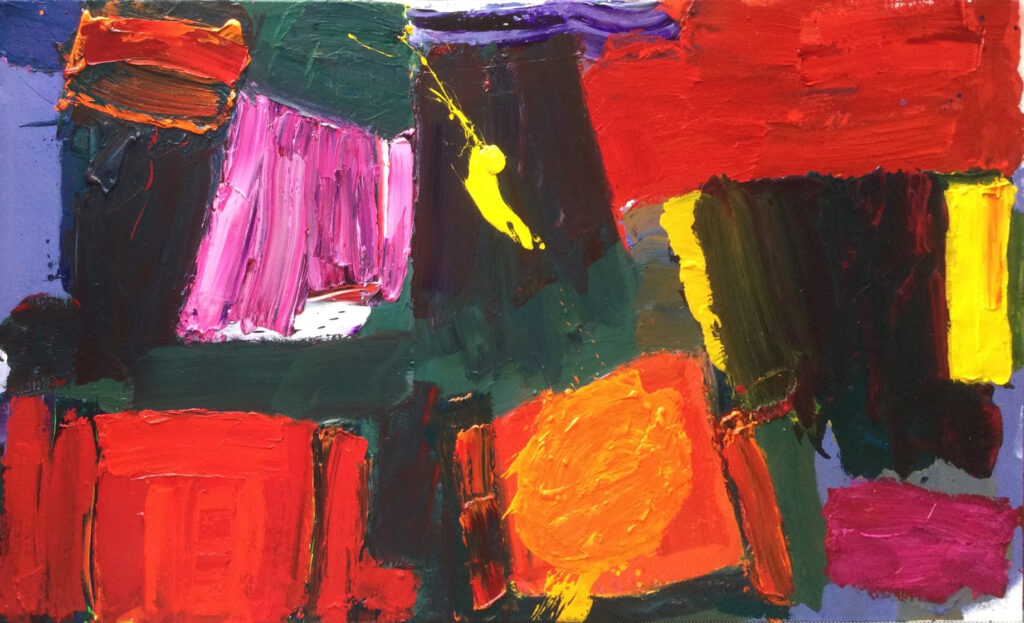
Early years of painting
MD: There’s a point in the late 1960s at which you’re making work on shaped canvasses- influenced, I think, by Richard Smith?
AG: That’s right. You may remember in my Instantloveland ‘Eye Opener’1https://instantloveland.com/wp/2019/03/12/1543/that I wrote about the big 1964 Calouste Gulbenkian exhibition, ‘Painting and Sculpture of a Decade’? It was a comprehensive survey of everything going on in painting, both figurative and abstract. That was a key point in my development, because up till then I’d been up in Edinburgh, at university, and I’d just come back down to London.

The show was a curatorial bombshell. It was designed by Peter and Alison Smithson, it was held in the Duveen Galleries, it was all presented on screens, and it was deeply unsatisfactory, because of the high toplighting. Anyway, the paintings I’d been admiring in books- books such as Skira’s ‘Contemporary Trends’ series, which had really good reproductions of De Kooning, Rothko, Still- I saw in the flesh for the first time. The painting I singled out for praise in my ‘Eye Opener’ was a Clyfford Still; but the show then moved on into European figurative painting, such as Renato Guttuso, and abstractionists such as Alberto Burri and Serge Poliakoff, and from there on into Pop Art- Warhol, Lichtenstein, Dine- with the message coming through strongly that this was the very latest thing; the exhibition felt like it built towards it. There was a Ken Noland in the show, and a Morris Louis, but I didn’t even notice them; they meant absolutely nothing to me at that time. And following on from this show, we had Bryan Robertson’s big survey of Jasper Johns, and then a big Rauschenberg show, at the Whitechapel; and so, for a time, I was swayed towards this kind of work. At the time, I was working at the British Council, where the walls were covered with Pop Art, and with works by the ‘Situation’ artists…
MD: But to understand your work at the time: am I right in thinking that apart from watercolour sketching in front of a landscape motif, you jumped straight into abstraction with both feet when you began painting in earnest?
AG: Yes. And I was very influenced by reproductions of work by the Abstract Expressionists. There was a period of De Kooning- when he was painting ‘Door to the River’, ‘Suburb in Havana’, ‘A Tree Grows in Naples’– all those big, brushy, landscape-inflected paintings- that influenced me, as did the work of Adolph Gottlieb.
That was my background, my beginnings in painting, before I arrived in London; when I got there, I was swamped by Pop Art, and briefly aligned myself with it…the reason I mention this is because I’m recognising that this is something that happens to young artists, they feel the need to be current, to be right up with the latest trends, the latest thing. And it can be a dangerous state of affairs.
MD: And you freely acknowledge that happened to you, at that time?
AG: Yes, it happened to me. And once I’d worked my way through those influences, the next stage was the shaped canvas, which was a huge trend during the 1960s. Apart from Stella, there was Larry Zox, and David Novros, who made multi-panel paintings; and in the UK, of course, the prime exponent was Richard Smith. I’d already been involved with him, because he’d been chosen to show at the Venice Biennale in 1966, for which I’d been Exhibitions Officer. His paintings of the time were aggressively three-dimensional, they were big boxes coming out from the wall. I didn’t care much for the Pop Art aspect- that they were derived from cigarette packets and so on- but I was interested in the bigness of the shapes.
I won a prize at the 1967 John Moores exhibition for a seven-panel shaped canvas work entitled ‘Downward’. I don’t have a colour reproduction, alas; but it was almost monochromatic, painted in burnt umber, with a central panel of a slightly different colour. Symmetrical, with three steps, as it were, on either side of the central panel, almost as if a Barnett Newman had been projected into three dimensions. This sort of thing was all the rage at the time; so there I was again, being influenced by the latest trend.
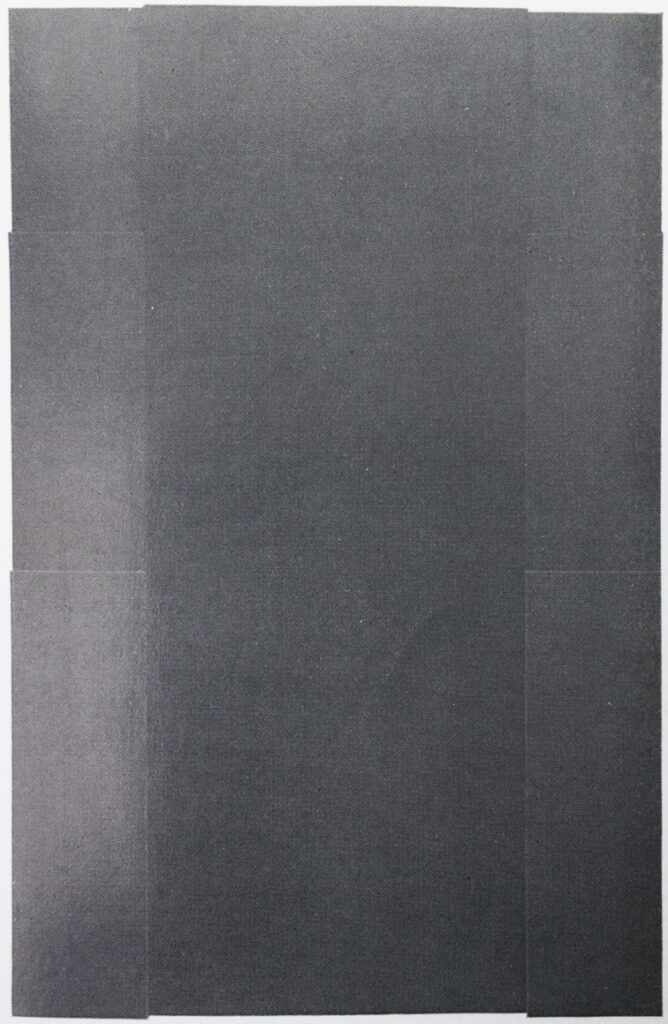
MD: At what point did you see the light, so to speak, and fight free of all these influences?
AG: Since I’d won the prize at the John Moores, I was included in an exhibition at London’s Camden Arts Centre, organised by Peter Carey, who we all thought was destined to be the next big noise in Gallery directorship, a real Nick Serota- although Serota himself was still in short pants at the time, of course. For this show, I produced two big shaped canvasses, which were around seven feet high, and fifteen feet wide; and they were like big slices of cheese, projecting out about eighteen inches at the bottom, and about nine inches at the top.
MD: You built the stretchers yourself?
AG: No, I had them made; this was the way everyone operated. Richard Smith had his stretchers made, and he simply stretched the canvas over them.
One of the paintings was called ‘Cattle Catcher’ because it had this big prow on the front, like on the trains that cross the American prairies. I’d become quite friendly with Phillip King, so I was keen to hear what he thought of them; he went along, and had a look, and said: ‘Yes, they’re impressive. But it’s not really painting, is it?’ And I thought, well, I know what he means, because he was a huge fan of Matisse, and he understood that painting meant actually working with paint, for starters (laughter)…and these paintings of mine were just one-coat jobs, the stretcher had been built, the canvas had been stretched, and the paint had been applied like painting a door.
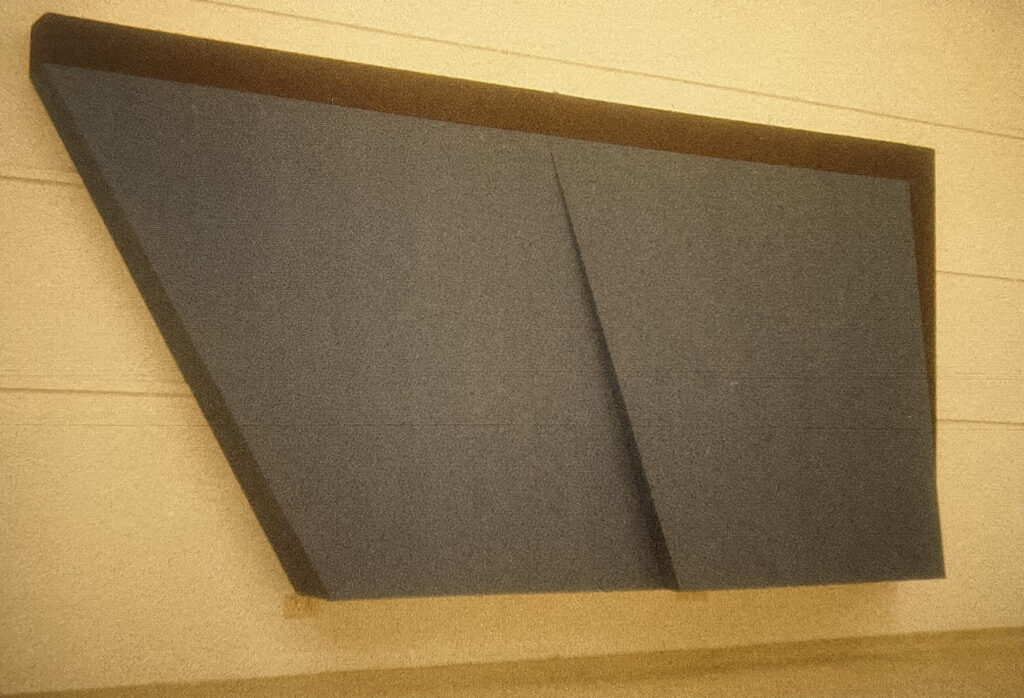
MD: Was there any modulation in the colour?
AG: Not in the colour, no, but the panels in themselves differed from one another. I did experiment with different colours and with different groupings of canvasses; but these projecting works of mine, they weren’t actually far away from what King was doing in his sculpture at around that time, and in truth I hadn’t even noticed that. There’s a sculpture of his called ‘Blue Blaze’ which consists of two or three big cubes standing in a group with some big columns, all of them painted in this same electric blue colour. And King said to me, the logical extension of what I was doing would be a move into full three-dimensionality, and that I really didn’t want to do, for a number of reasons; not least, because the shaped canvasses were so bulky and difficult to store. I couldn’t hang on to them in the end.
MD: So really, King’s criticism of these works was that they were sculptural, but not fully so? Not sculpture in the round. A hybrid, with sculptural aspirations but lacking sculptural convictions?
AG: Yes, a halfway house. In much the same way that so much of the production of what we might call the counter-culture has been a halfway house: multi-media, interdisciplinary work, installation, works that hang from the wall but spread across the floor…
In other words, I began to understand that painting has limits, and should have limits; that it is essentially a membrane, a taut surface. I recall Patrick Heron at his Tate retrospective, saying that a painting lying on the ground is not a painting: that painting is a surface at eye level, on the wall. And anything that sticks out from its surface is irrelevant. The third dimension in painting is always fictive, a result of its illusionistic properties.
MD: When exactly did you undergo this Damascene conversion to an understanding of the flatness of the canvas as indispensable to painting?
AG: In 1968 or 1969. I was working on cotton duck, laid on the floor, and I was pouring oil paint onto it, into it. I’d lay down a large sheet of cardboard, lay the painting on top of it, and soak it, in much the same way as Morris Louis or Helen Frankenthaler, but with the difference that I was using oil paint on raw cotton duck, which is technically extremely hazardous. This is why I haven’t been able to keep many of these works.
MD: The oil rots the canvas fibres, doesn’t it?
AG: Yes, but at the time I didn’t care, because I wanted the staining to go in really deep, rather like Jackson Pollock’s black paintings, in which he used enamel paints, and there’s a halo of dried oil around the marks, which isn’t pleasant. Then I’d flip the paintings over, face down, onto the cardboard to soak up surplus paint; and in some cases I’d end up working on the back of the canvas rather than the front.
Sculpture
MD: By this point, by the end of the 1960s, you’re very much involved with St Martins, of course.
AG: I was offered a teaching job at St Martins in 1967, thanks to my friendship with Caro, King, and Isaac Witkin, who all recommended me for a post; but I’d never made a sculpture in my life, how the hell was I supposed to teach sculpture? My role was to chair the Sculpture Forums and get groups of people together and organise debates; that’s how it began for me.
MD: You’re well aware of our interview with David Evison2https://instantloveland.com/wp/2021/07/23/a-fly-on-the-ceiling-matt-dennis-in-conversation-with-david-evison/since you contributed extensively to the comment thread; and you’re aware that he describes the Forums as something akin to the Roman gladiatorial arena. According to him, people were being thrown to the lions, and you were overseeing it…
AG: I was a mediator, trying to, well, to mediate…(laughter)
MD: But David makes it sound savage.
AG: But you have to understand, the difference at that time between St Martins and any other art college was that you didn’t have a cubicle system where tutors came in and saw a student individually, and said, well now, I see that you’ve got a photograph of Elvis Presley there (laughter)…nothing like that. It was all open, communal activity; partly because of the structure of the building. The sculpture department was divided into several areas, none of which had any technology, other than a woodworking machine. Totally unlike the RCA in that respect, which had all this machinery for the cutting and bending of steel. At St Martins, you had the studios up on the top floor, where Caro used to conduct his classes; you had the Diploma Course (as it was just becoming then) in the middle floor studios, which William Tucker had been invited in by Frank Martin to run, and to give some sort of intellectual backbone to; and then you had the welding shop, for oxyacetylene and arc welding- and there I think there might have been one small machine for bending steel. Primitive stuff. And out the back of the school, you had the stone-carving area, where people like the Israeli stone carvers who’d come over specially could do that sort of thing. And above it all you had the asphalt-covered flat roofs on top of some of the studios, where you could lay out sculptures to be looked at. But all of it was really all over the place, very chaotic.
MD You were brought into this chaos to run the Forums…
AG: But I was also brought in because of my contacts within the art world. I’d been an Exhibitions Officer for three years, and I knew a great many people…
MD: But it was understood that your credentials for critiqueing sculpture were simply that you had a well-honed critical eye, rather than ‘here’s my sculpture’?
AG: Well, I had also had a hand in organising shows of sculpture, such as the ‘New Generation’ Whitechapel show, which had travelled round Europe, taking me with it…
Bear in mind that at St Martins, I was also put into the first year of the Diploma course on a two-days-a-week basis, presumably in order to learn the nuts and bolts; because all the knowledge I had of sculpture was theoretical, if you like, and aesthetic. When Frank Martin had me on trial to see what I was like, somebody brought sculptures in and he came in and listened to me talking about them.
When I was at the British Council, one of the shows I’d had to organise was a photographic touring exhibition about Henry Moore. Moore was everywhere at the British Council, he was God. It was hard to tell whether the British Council was running him, or if he was running the British Council. He was the British Council. And of course, they had great success off of that.
So, if you ask me what I knew about sculpture then, I can say that my knowledge was cumulative, I knew about Moore; and I knew all about what was thought and said about him, and then I’d got to know the ‘New Generation’ sculptors, Caro, King, Tucker, Tim Scott, and so on; I’d got to know nearly all of them personally and had toured Europe with their work, and had got into various spats over it.
I’ll describe one. In 1967 we toured the ‘New Generation’ sculpture: but to give a little context, I should explain that the Venice Biennale of the previous year had been a sort of pivot point, between the old school in British art and the new, the latter being represented by the ‘Situation’ artists and those that followed afterwards. And so it was that Bernard and Harold Cohen, Robyn Denny, Richard Smith and Anthony Caro were all chosen to be in it.
The first stop on the European tour of the ‘New Generation’ show was the Kunsthalle in Bern, in the German-speaking part of Switzerland, a place we could describe as the area’s commercial capital. Harald Szeeman was the Director of the gallery, and he was a high-flying, ambitious curator- one of the band of people I like to describe as ‘tin-pot Diaghilevs’ (laughter). (Subsequent to the episode I’m going to describe, he made his name with ‘When Attitudes Become Form’, the exhibition that showcased all manner of Arte Povera and ‘Anti-art’, in which he posited curatorship as an art form in its own right; he was the first to do that).
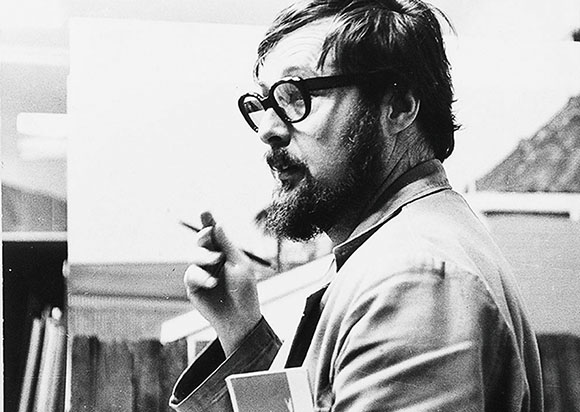
Anyway, shortly after the sculptures arrived, Phillip King, Isaac Witkin, David Hall (who used to make big, boxy, folded-steel white sculptures) and Derrick Woodham all flew out to Bern for the opening of the show. Come the opening night, this herd of bankers and solicitors came piling in; they’d heard what it was all supposed to be about, it was going to be Swinging London…Harald Szeeman had organised this lightshow to be projected onto the walls, images of hippies painting one another and smoking pot, and it was all being projected across the sculptures. Meanwhile, people were walking all over the sculptures, such as King’s sculpture ‘Slant’, which stacked vertically and slanted across the floor; women in high heels were trampling all over it. People were sitting on Bill Tucker’s big stacks of fibreglass cylinders, damaging one of them, so that he had to fly out to the next venue, Düsseldorf, to repair it.
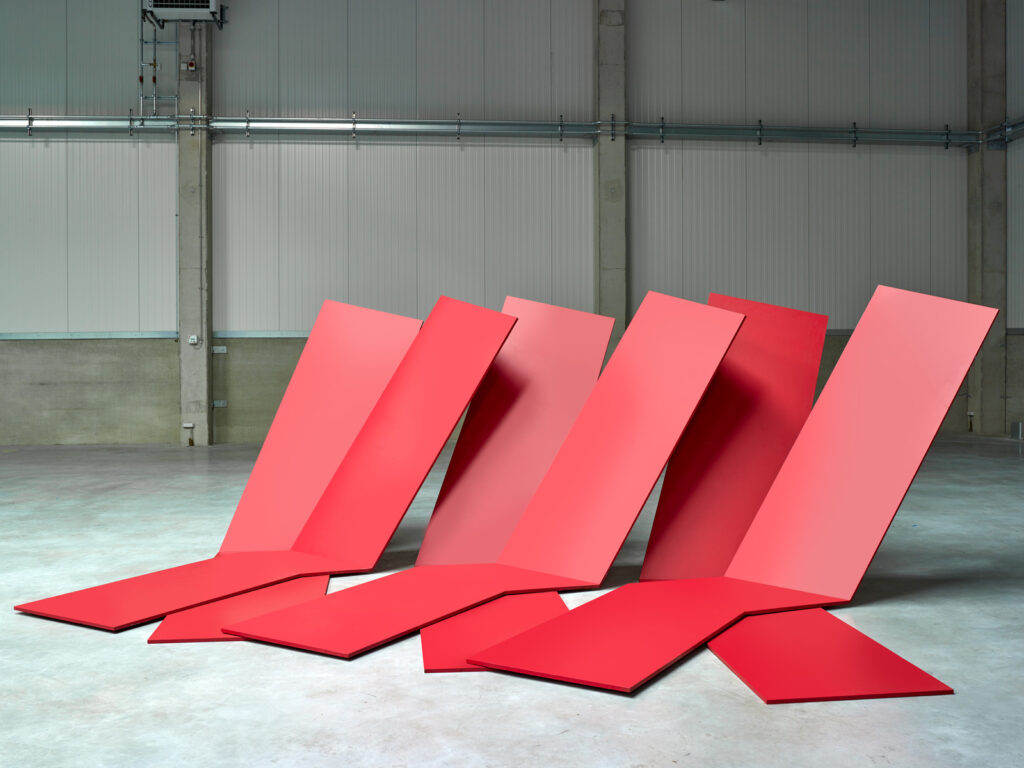
Szeeman was tittering away, and I could see that King and Witkin were looking horrified, so I went over and spoke to them, and I asked them, what do you make of this? What are we going to do? And they said, this is just terrible, we want nothing to do with any of this. So I got hold of the microphone and I said, on behalf of the sculptors who are here today, I want to say that this is an atrocity, this has absolutely nothing to do with what these sculptures are about; and if you want to find out what it’s really about, I suggest you come back on another day when it’s quiet; and while you’re at it, get off the sculptures.
And Szeeman’s face went purple with rage, because he had been busily carving out a name for himself in the curating world, trying to bring together all the latest, the coolest things…the day before, he’d gone to the trouble of dragging King and myself to a showing of Kenneth Anger’s ‘Scorpio Rising’ in a dingy basement, when we’d wanted to be out in the sun exploring the town. That gives you some idea of the man.
Anyway, when we got to the next venue for the tour, the Dusseldorf Kunstverein, another Harald, Harald Behren, the Director, met me at the door as I was coming in with the sculptures and said ‘This is our exhibition, not yours.’ Word had obviously reached him. ‘You will participate in putting up the sculptures, but after that you will play no further part.’
My aversion to all forms of counterculture ‘subversion’– and to what I call the counterculture consensus as well- dates from this time and this experience.
AG: So, you were asking me how I came to know anything about sculpture…
MD: Yes. Was your experience at St Martins a case of what is now called ‘fake it till you make it’?
AG: Truthfully, I didn’t have any views about sculpture to begin with; my views developed gradually over time, as a result of seeing where all these different cross-currents were heading…
MD: So getting you in there in the first place had more to do with your mindset and your aptitude, rather than a CV as long as your arm.
AG That’s right. You see, Frank Martin was great at bringing all sorts of people in: he brought in Will Allsop, the architect, he brought in Richard Latrobe Bateman, the furniture designer…Frank was great at man-management, and he liked to stir things up; he encouraged the anti-Caro faction within St Martins, in a way, simply because he realised that students were moving in that sort of direction anyway. We had Gilbert and George, Hamish Fulton, Richard Long, all those people were there in my first year of teaching.
I wasn’t happy ‘teaching’ sculpture, in inverted commas; I never actually taught it. I commented on what people were doing. I applied for teaching jobs in painting at Liverpool and Canterbury, but thanks to the politics of the time, the successful candidates were inevitably internal appointments; they didn’t want disruptive outsiders coming in. I tried for a job in the painting school at St Martin’s, under Freddie Gore, but it went to John Edwards; despite the fact that while we were sitting waiting to be interviewed, John said to me, ‘you’re bound to get it.’
At St Martins, there had been pretty much no contact between the painting and sculpture departments, they were on different planets. The painting department resented the success that the sculptors had been enjoying, whilst they had little or nothing to show for their efforts. Freddie Gore was a very good head of department, but he didn’t have Frank Martin’s level of ambition; Frank wanted to put St Martins sculpture on the big stage, as it were.
MD: I’m assuming, since Freddie Gore was a figurative painter, that the painting department wasn’t the temple of new abstraction that the sculpture department had become?
AG: The painting department had a much bigger part-time staff than the sculpture department, many of them linked to the Royal Academy, where Freddie Gore was a major player. To be honest with you, I have very little recollection of the painting department until around 1974, when Gillian Ayres was there, as senior lecturer. She wasn’t a leading light; she was just one of the people on the staff. Shortly after that, John Edwards was appointed Head, and then Bruce Russell. Marc Vaux was also a fixture from the early 1960s. Alan Reynolds had been there since the 1950s; he’d begun as a landscape painter hailing from Suffolk, but he morphed into a radical constructivist, making white-panelled paintings.
MD: In the mold of Kenneth and Mary Martin?
AG: Not quite as bleak as that (laughter). More like Mondrian, but without the use of black, if you can imagine that. The thing about the painting department was that there was no direction to their teaching, as far as I could make out. It was like so many other art schools, where you have so many conflicting voices.
MD: My impression of the sculpture department is that it was evangelical in its mission, because by the end of the 1960s so many by then renowned sculptors were involved with it, pushing it along; but the painting department really had none of that? no corresponding sense of a dynamic, or a direction?
AG: They wanted to emulate the sculptors’ success, but they didn’t want to go about it in the same way. The painting school ran on the cubicle system. But beyond that, I know so little about what was going on with them, so it’s possible I’m maligning them.
MD: Well, you’re not passing judgement on the quality of what they achieved, are you? You’re simply acknowledging that the painting department wasn’t a movement in itself, which is what the sculpture department had become in the late 1960s.
AG: The person you should talk to in connection with the painting school is James Faure Walker. He moved from the sculpture department to the painting department in 1967. He was one of my first students, but I didn’t teach him anything (laughter).
By the time I fetched up at St Martins, there was a renegade, anti-Caro movement in the sculpture department; even among the people who were making Caro-esque constructed sculpture. Peter Hide, David Evison, John Hilliard, Gerard Hemsworth- they were all there in the year I started. The very first Forum I attended, they were on the panel, and they were all having a go at Caro, ribbing him; and of course, he loved that sort of thing.
Bruce McLean had already come and gone, and he’d rebelled, as had Barry Flanagan- he’d been involved in organising that notorious episode with John Latham, during which Greenberg’s ‘Art and Culture’ had been chewed up and spat out. Richard Long was by this point already doing his walks, and coming in with twigs from the Cotswolds and sticking them on the wall. Caro, Tim Scott, Phillip King and I were invited by Long up onto the roof at St Martins to view his latest work, and to critique it. We went up there, and there was a pile of sand- no, scratch that, not even a pile of sand, a puddle of sand- and we had to stand around and talk about it. Words were exchanged: to the effect that this was English romantic nostalgia-
MD: …for the sandpit?
AG: It wasn’t ridiculed; we tried to talk about it. But really, what is there to say?
MD: Was there an audience of students for this crit?
AG No, not on this particular occasion; but there often was. And the students were given free rein to say whatever they felt like saying, for or against, and we staff stood around in groups. Caro would typically come in on a Thursday, and say, let’s walk around, see what’s going on. It didn’t matter whether the student was Advanced or Diploma, if there was something to be seen, we would see it. We’d say to the students, we’ll have a look at yours, and yours, and yours- we’ll go grab a coffee and we’ll all meet at 11am. And then there’d be this open sort of argy-bargy…some people can function well under that sort of pressure; others are simply intimidated, obviously. But what you’d get after it was all over was members of staff who didn’t approve of this sort of thing coming round and saying to the stricken students, oh, don’t worry about it, they don’t know what they’re talking about. But I will say that, by and large, it was a public, open forum, and that’s how it worked, and that was what was great about it.
I’ve been in art schools where you go there in the morning, into a little cubicle, and the student has arrived late and has got virtually nothing to show you, and you have to look around until you find something, and you end up saying, oh, what’s this photograph about?
MD: So there was something essentially meritocratic about the St Martins method: you walked around and looked until you found something that stood out, regardless of who’d made it, and you talked about it.
AG: Yes. And it didn’t only happen when Caro was there; but it always did when he was, because he liked to do it.
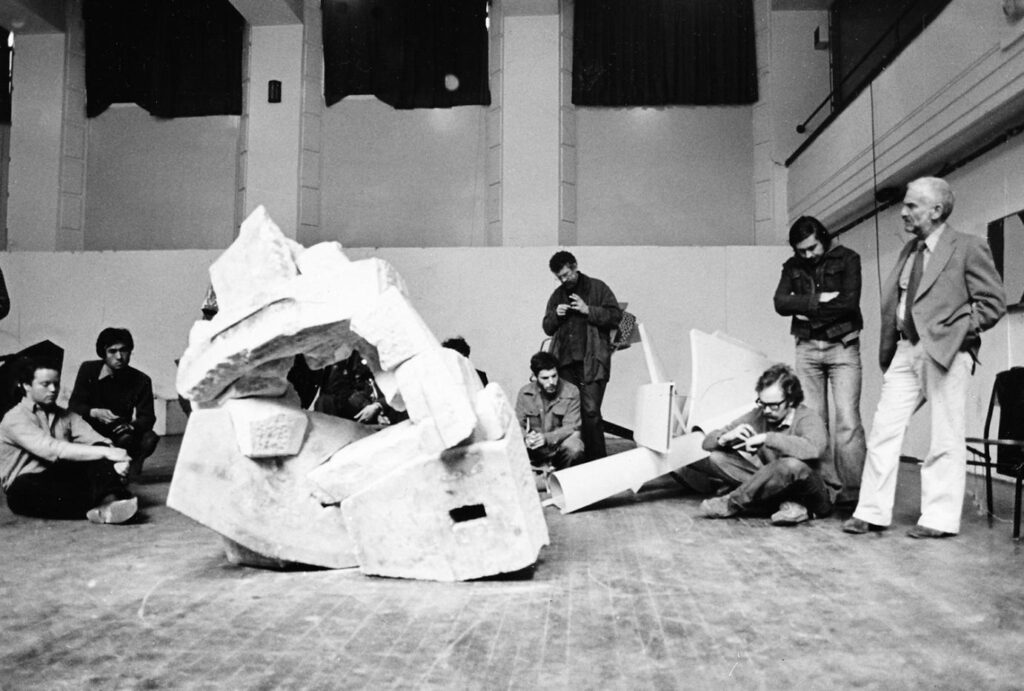
Some of the people on the Advanced Course had pretty healthy egos in their own right, and were perfectly able to stand up for themselves, and to be confrontational, aggressive even, and say to us, I think you’re talking nonsense. Others would be more sheepish, or simply listen to what everybody had to say. It was only gradually, over a period of years, that it started to dawn on me that what Caro was doing was teaching from the perspective of his own particular way of working, and that anything he deemed to be lying outside of that would be roundly criticised. Typically he’d say: ‘Turn it upside down!’ The student would have been working all week on the thing, made out of wood and dowelling, and Caro would say, let’s have a look at it from underneath; and it would be turned upside down, and bits would fall off it, and Caro would pronounce ‘There! It looks better that way.’ This, I realised, was not the right way to go about things.
MD: His teaching had the outward appearance of a free exchange of ideas, but it was really a form of egotistical coercion?
AG: I wouldn’t put it that strongly, not quite. There were, for him, shall we say, certain ground rules for what sculpture could and couldn’t do: no closed boxes, for instance. Everything had to be open; and anything that was built in an architectural sense, again, no. This was how Caro’s own sculpture had evolved: it was a form of disguised engineering, if you like. Whatever engineering that was present in the thing was so dispersed that you couldn’t trace it; that was his style. But of course, there were other sculptors there, each with their own viewpoint; Phillip King, to name but one. Things came to a head, eventually, around 1977 or 1978; one particular advanced student had made a big sculpture in wood that was rather like one of David Smith’s Cubi. It rose off the floor, projecting this way and that, and it had some Brancusi-like wooden carving to it as well. It stood in gravity, it cantilevered, and so on. Tim Scott was there, and he gave a very logical, rational account of what the sculpture was doing, because it had certain resemblances to his sculpture also; all very convincing. And then Caro said, ‘Well, yes, but what you could also do is turn it upside down and put it in a niche in the wall.’ Which moved me to respond, you’ve just flatly contradicted everything that Tim Scott has said; and you can’t both be right.
MD: When you did actually get round to making your own sculpture, how much did you make?
AG: Three or four, in the basement at St Martins. I was doing them after hours, after a day’s teaching, and it was physically exhausting.
MD: With technical support?
AG: Yes. Stan Brobyn taught me how to weld using the oxyacetylene. But that was so laborious, and used up so much gas, that I switched to arc welding. You’ve seen the photographs of my sculptures?

MD: I’ve seen a photograph, just one. What became of them? Are they still extant?
AG: Oh no no no. They just got broken down, and other people cannibalised the parts.
MD: Around this time, Noland and Frankenthaler made sculptures; did their work feature in your thinking, as a painter-turned-sculptor?
AG: No. It happened like this: I used to go off to the scrapyard in the van with the students to buy all sorts of scrap; and I saw this stuff, and I thought: I’ll have some of that. I retrieved some big, squashed steel pipes- they’d been through a guillotine and had their ends crushed-
MD: Pinched off, like sausages?
AG: Yes, or like ravioli (laughter). That was some of what I used. I was just learning as I went along…
MD: Do you view the works as a brief flare-up of a sculptural impulse that then subsided?
AG: No, I thought I might be able to carry on. In fact, I went as far as buying an arc welder, and hoping that I might get a studio space at Stockwell. But with ‘Untitled I’– the best one- Caro came in, and said, let’s have a crit of it, with Tim Scott…
MD: Yikes.
AG: I thought then, and still think now that it’s a good sculpture-
MD: I’m very fond of it. Although I believe it earned you a critical drubbing?
AG: It was described as a ‘Gonzalez Gouk’ (laughter) because it was sort of rustic as well, with all kinds of ironmongery. And here’s another one, ‘Untitled II’ which is sort of flatter, with this sort of bracketing, which was a found object. Of all of them, I think these two are the only ones that were any good…

MD: They’re putting me in mind of Caro’s ‘Flats’– was he busily noting what you were doing at this point?
AG: Oh no no no. Not in 1972, at any rate. It was the other way round: ‘Untitled II’ was derivative of Caro; but ‘Untitled I’ definitely wasn’t.
MD: I expect these were probably disliked on account of the anthropomorphic traces they carried?
AG: Oh, and because it was standing up…Caro’s sculptures were all laid out across the ground. And to top it all, ‘Untitled I’ had this kind of crown on it…
MD: Yep, you broke all the rules (laughter).
AG: And Caro waded in and said, you’re setting the students a bad example, doing this thing, it’s like a Julio Gonzalez-
MD: In other words, a backward step.
AG: Yes. But nevertheless, as I said, I happen to think ‘Untitled I’ a very good sculpture, actually.
MD: Have you got documentation of all the ones you made?
AG: There are two or three photos; but I’m really not trying to put myself forward as a sculptor. Anyway, being on the receiving end of a critique made me realise that something was amiss with the whole process. Caro kept asking, what’s your intent? What is it you want to do? And I had no fucking idea what I wanted to do (laughter). Most students don’t know what they want to do. To this day, if I’m starting a painting and someone were to ask me ‘What’s your intent?’ I’d say fuck off, I haven’t got an intent (laughter). I’m just exploring something, trying something on for size. To be able to articulate it in words before you’ve done it? No no no. But this was the way in which Caro would criticise students. And not just him: lots of tutors do this.
MD: But wouldn’t you agree that it’s a hell of a lot easier to work in a free, improvisatory manner in painting than it is in sculpture? If you’re gathering heavy, cumbersome pieces of scrap metal in order to make sculpture, aren’t you going to have to have the semblance of an idea of where you’ll be starting from, and where you’ll be heading, wouldn’t you say?
AG: Alright, granted, but the fact is, I really was just putting bits together to see what would happen. And when Caro asked me, what’s your intent here, in order to have something to say, off the top of my head I came up with this argument that since drawing had been pretty much banished from abstract painting, then perhaps sculpture was drawing’s true home? And I claimed I was drawing with the metal. And something in what I said must have struck a chord: because then Caro started doing just that.
MD: Caro’s ‘Table Sculptures’ are full of drawing, aren’t they?
AG: Yes, exactly. And it was around that time that he began making them.
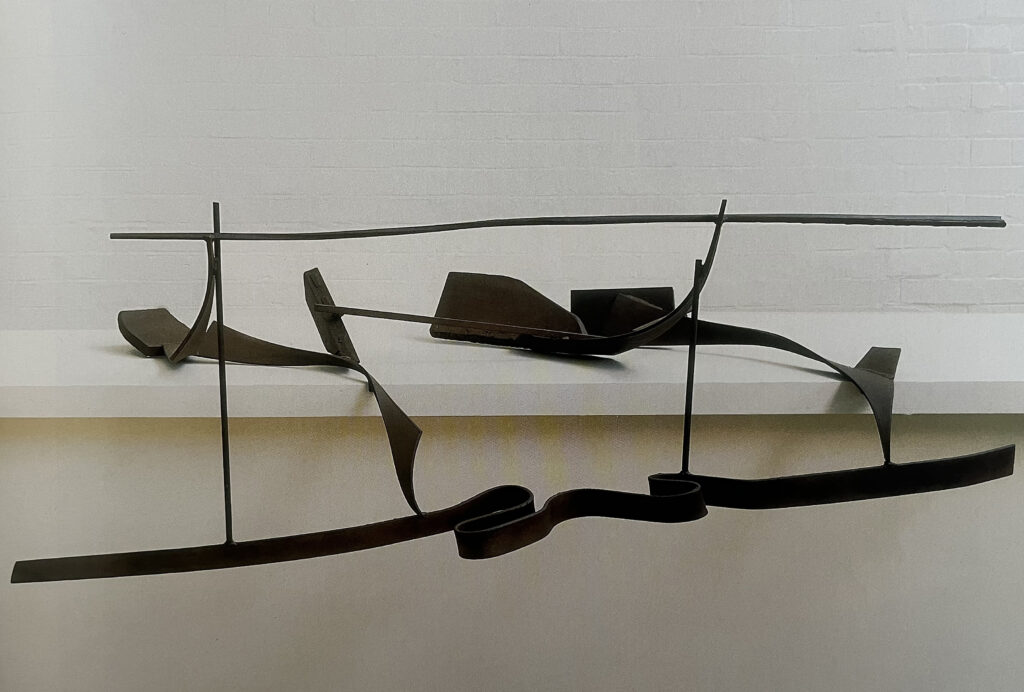
MD: Your raising of this question of the role of drawing in sculpture prompts me to ask about John Panting. You rated him very highly, didn’t you? At least, you rated the sculptor he became; but the gist of what I’ve understood about your reading of his work is that you felt he started out by simply ‘drawing’ with lengths of steel, but then went on to shape space in a truly sculptural way?
AG: The gist of what was said at John Panting’s Forum session at St Martins, where he’d been invited to bring his work in- and whether I said it or someone else said it, it seemed to be the consensus view- was that he was using square-cut steel bar, the sort of material an architect would use for a staircase handrail, and that he was using it in an architectural way, without feeling it as a material; without sensing its weight, its pressure on the other elements within the sculpture, and so on. It was too design-y and too graphic.
There was a close link back then between what Panting was doing and what Bill Tucker was doing with his ‘Cat’s Cradle’ pieces, and his thin rod pieces which created trapezoid volumes in space; Tucker talked about the conflict between what you see and what you know: a rectangle doesn’t look like a rectangle when it’s rendered in three dimensions, and it’s receding away from you. He was very involved with the phenomenology of perception, and with gestalt theory. Panting too; and they influenced one another.
So, that was the critique of Panting’s work at that juncture. And what happened after that was that Panting underwent a huge explosion of creativity, and did some truly amazing stuff. I praise his late work in my second essay on steel sculpture.3Gouk, A., ‘Steel Sculpture Pt 2’, https://abstractcritical.com/article/steel-sculpture-part-ii-from-scott-tucker-and-panting-to-the-present/index.html

Most of my writing about painting has not been criticism, but simply responses to various exhibitions I have seen. I won’t really write at all unless I’ve been to an exhibition and been affected by it. For instance, there was a huge retrospective of Pissarro at the Hayward Gallery in the 1980s, and that prompted me to write; but I wouldn’t consider it so much criticism as an article about the artist and the work. My writing on Heron, again, is not so much criticism as an attempt to paint the big picture of the man and the work.
For me, the situation is completely different when it comes to writing about sculpture. The first major article I wrote about it was ‘Proper to Sculpture’, which was written in 1978 and 1979, and published in ‘Artscribe’ in 1980. At the end of 1976 I was recovering from a really bad bout of ‘flu that affected me for three months, and I hadn’t been able to do all that much apart from go to the library near where we were then living, in Stroud, and there I stumbled across a book called ‘The Sculpture of the World’ by Sheldon Cheney. There was very little text; it was a photographic exploration of world sculpture from the Venus of Willendorf, through Mayan and Cycladic, Japanese and Chinese sculpture, and so on…and looking through it all, I had a kind of revelation. Western European sculpture didn’t look all that good by comparison: its obsession with the nude body, expressed through the pictorial values of Bernini and Michelangelo, and in its twentieth-century manifestations, such as the work of Brancusi, its preoccupation with an African model of sculptural form that far outstrips it. Brancusi’s ‘Bird in Space’ looks like an over-refined piece of Art Deco next to the African works from which it supposedly derives. Henry Moore’s early stone carvings, good as they are, can’t hold their own next to the best of the Mayan carvings.
That’s where I started; and it developed into a critique of cubism, and of Greenberg’s view of modernist sculpture as having its roots in cubist collage. I was lucky enough to have the precedent of William Tucker’s book, ‘The Language of Sculpture’, which had been published a few years previously; it’s a forensic examination of all the pathways of twentieth-century sculpture that don’t depend on cubism. From there, the next thing to come my way was the big two-part survey of British sculpture at the Whitechapel, which began with Gaudier-Brzeska and Epstein, and on into the 1920s; and, not even realising that there was due to be a second part, I wrote a very severe critique of the first part. The second part kicked off with the ‘Geometry of Fear’ group- Lynn Chadwick, Reg Butler, Kenneth Armitage, Bernard Meadows, all the sculptors that Herbert Read promoted; then Caro’s early clay figures, and then Hubert Dalwood, Robert Clatworthy, and right up to Glynn Williams, who showed a carved stone ‘Mother and Child.’ (At Stockwell in 1979 he presented a huge wooden construction called ‘Rhino’, which I have no idea how to describe.)
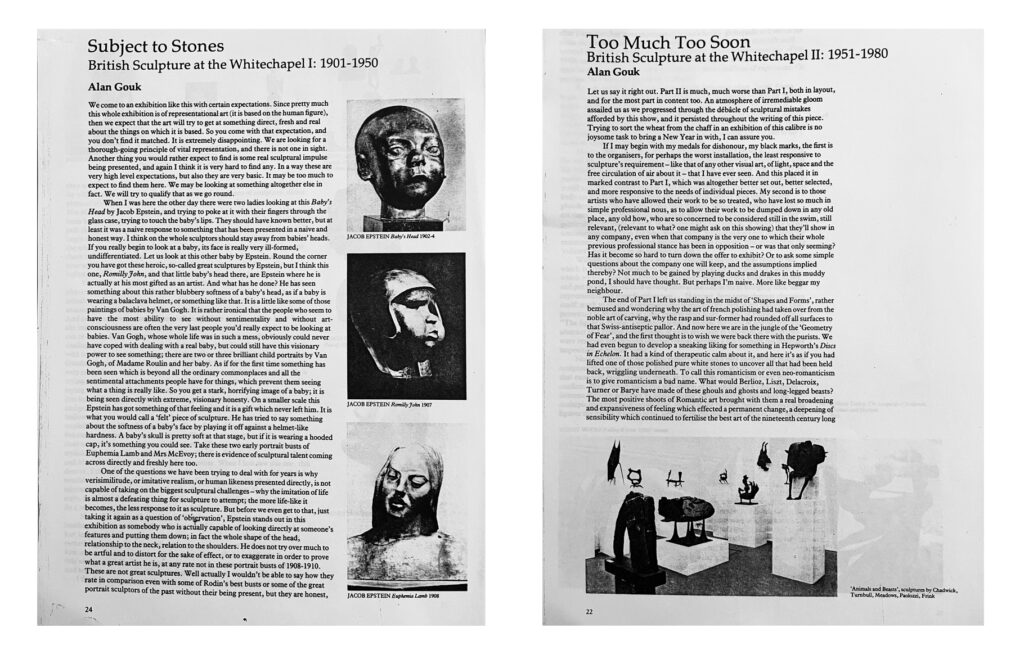
Anyway, having applied my somewhat bitter and damning critique to the first part of the show, I could hardly pull back when it came to the second; so I was equally trenchant in my attack on it, and of course on the work by Caro included in it. And this was where my troubles with Caro really began in earnest; but I’m not going to go into all of that here.
Once my reviews of the two shows had been published, Glynn Williams piled in with ‘There sits our sulky, sullen Dame, nursing his wrath to keep it warm’– quoting Robbie Burns. So I wrote a reply which began ‘Fair fa’ your honest, sonsie face, Great Chieftain o’ the Puddin-race!’ quoting Burns back at him; but they wouldn’t print it.
MD: Can’t imagine why not… (laughter).
AG: The point is, all my writing about sculpture is actual art criticism; I’m not a sculptor, so I applied a particular set of criteria based on my feelings about structure and form, and found in doing so that I had very little time for Tony Cragg’s plaster bottles laid out in rows, or for Richard Long’s work; I already knew, as I mentioned much earlier, what I felt about him from the time when he was a St Martins student.
So there’s a difference that needs to be understood. When I’m writing about painting, I’m writing as a painter, fully immersed in the practice of painting; but when it comes to sculpture, I’m writing with a set of ideas about what sculpture should be.
MD: When you’re writing about painting, it’s presumably with a greater sense of immediacy, because instinctually or otherwise, you’re measuring what you’re looking at and writing about against your own painterly practice…
AG: Exactly. Or against my own as-yet-unfulfilled wishes for my own practice.
MD: Also, it would be fair to assume that the painting you’re writing about occupies territory not too far distant from that occupied by your own work?
AG: Yes, absolutely, because I wouldn’t waste my time writing about something I didn’t like. I’ve only ever written about things that I’m- at least mostly- positive about.
MD: And because you’re not a sculptor, when writing about sculpture then all of it is in a sense fair game, because you’re equidistant from all of it, and feeling no bias? Although I should say again here that I rate the few forays you have made into sculpture very highly, and it’s a perverse quirk of your career that there aren’t fifty more of them, or a hundred more…
AG: No, no, none of these sculptors would ever consider me a sculptor. To be a sculptor you have to have done a great deal of work, not just two or three pieces like I have.
But anyway, the corollary to all that, or the sequel to it, is that the Stockwell sculptors, Tony Smart, Katherine Gili, Robin Greenwood, all picked up on these ideas I’d presented. My article, ‘Proper to Sculpture’, I first delivered as a talk, complete with slide show of comparisons between images of different works, at St Martins in 1979, and Peter Hide was in the audience. I was making direct comparisons; for instance, a New Hebridean sculpture against a Michelangelo…
MD Rather like André Malraux’s ‘Museum without Walls’?
AG: Exactly, exactly…although at that point I hadn’t read any Malraux. Well, Peter Hide piped up and said that I must have been reading Roger Fry’s last lectures, and I replied, no I haven’t; but I pretty soon did. I went out a bought a copy of Fry’s last lectures, and lo and behold, he had been doing a much better job back in the 1920s and ‘30s of saying the same kind of thing that I’d been saying; so I then began incorporating some of his ideas into the written version of ‘Proper to Sculpture’.
MD: And you feel that this critical position of yours vis-à-vis sculpture, that you’d arrived at by this point through all your reading and research, was something that Robin Greenwood et al came along and helped themselves to?
AG: Yes, they took up some of the thinking that was in ‘Proper to Sculpture’; but in the essay, I rule out the idea that you can take formal invention from figurative sculpture and transplant it into abstract sculpture, and they started doing more or less that. I then found myself in the position of defending the developments that Robin and his colleagues were making, even though I didn’t entirely go along with them; but they had been my students, and the fact is that they were doing very interesting things.
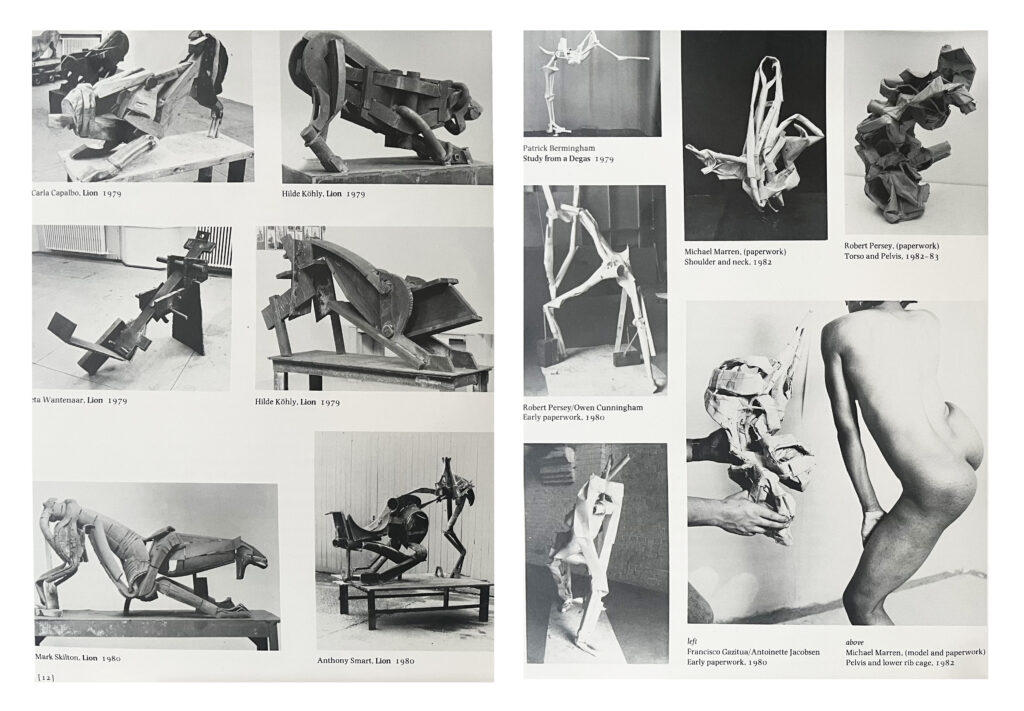
We had been finding that applicants for the Advanced Course were coming with slimmer and weaker portfolios, due to the practice of Foundation and Diploma Courses around the country of following the influence of fashionable tin heroes of the hour, with ‘Art Informel’ detritus, wire decked with feathers, ‘piss flowers’ and so on, with almost no sign that students had been encouraged to actually ‘make’ anything (in Tucker’s conception). So I decided to introduce the model’s body as a locus for understanding the physical reality of things in the world, in a way totally unlike the usual art school ‘life class’ conception. Simultaneously Tony Smart, who was teaching in the St. Martins Foundation Department, began a project working from an Ionian Lion in the British Museum, following a reading of Cheney’s survey. And when Tim Scott became Head of Sculpture in 1980, the first thing he did was to acquire a copy of the same Ionian Lion. It was intended simply as a student aid. But much to my surprise, some of the staff began to explore in the same way that the students had been doing. That’s how ‘Sculpture From the Body’ began.
You were asking me, what my criteria were when evaluating painting and sculpture. Well, when it comes to painting, I don’t have any criteria; you remember the articles I wrote for Instantloveland on Gauguin, Van Gogh and Matisse?4https://instantloveland.com/wp/2020/03/18/alan-gouk-gauguin-van-gogh-matisse-part-i-open-conflicts-hidden-affinities/; and https://instantloveland.com/wp/2020/05/12/alan-gouk-gauguin-van-gogh-matisse-part-ii-the-apotheosis-of-decoration/ I look and I compare and I make value judgements, based on what the paintings are showing me. When it comes to sculpture, the situation is different; I’m more detached, I’ve taken a position.
St Martins in Decline
AG: Do you really want me to go into the whole saga of the death of St Martins sculpture? because it’s horrendous…
MD: Yes and no. It’s useful up to a point, hearing all you’ve had to say about the sculpture school, as background and biography; but not if you feel it’s going to supplant consideration of the meaning of the work- both yours and others’…
AG: Well, where were you in 1983?
MD: I was a painting student at Middlesex Polytechnic, as it then was; the painting department was based in a converted factory space at Wood Green, just down the hill from Alexandra Palace.
AG: Your time there was precisely the time at which art schools started to come under this tremendous pressure from the CNAA5https://en.wikipedia.org/wiki/Council_for_National_Academic_Awardsto conform to their idea of what a Fine Art course should be. They had this philosophy- if that’s the right word- of imposing a modular credit system; they’d got away with doing it in the provinces, and now they were trying it in London, and the ILEA backed them. It’s a huge scandal, one that’s too big for me to go into here…
The rot had set in with the Coldstream Report,6from http://www.thejackdaw.co.uk/?p=1824: ‘It was inevitable that the Government would eventually have to get involved with art education. In 1959 William Coldstream, Euston Road School painter, principal of the Slade School since 1949 and, from 1958, Chairman of the National Advisory Council on Art Education, was asked by the Education Secretary to look into art schools, whose egregious anarchy was raising eyebrows in the papers. Part of the political objective in forming this committee was ultimately to make art education less expensive by, if possible, amalgamating institutions and departments, where this could be achieved, and by raising an agreed standard so that the eventual qualification became degree-equivalent – it would in fact take over a decade to integrate art schools indissolubly into the wider system of higher education. There was also a growing anti-élitist faction in government which believed that numbers in higher education needed to be dramatically increased to match levels of access to tertiary education witnessed abroad, where many times more young people were at universities. Coldstream was charged with making “recommendations dealing with the content and administration of courses for an award to take the place of the National Diploma in Design (NDD).”
The NDD had been created by the Ministry of Education in 1946. This Diploma was awarded as the culmination of four years of study, the first two of which qualified the candidate for a Certificate in Arts and Crafts. At the time of Coldstream’s appointment and his committee’s deliberations there were 106 art schools offering a two-year NDD producing around 1,700 students a year. The failure rate was just under a quarter, and the majority of those who passed who didn’t go into industry went on to teach at secondary level, where art was a subject taken far more seriously then than now.
The resulting Coldstream Report, a brief document of only twenty pages published in October 1960, and its fine-tuning supplementary addenda, called Summerson Reports, until the final Coldstream report in 1970, are frequently and flippantly claimed to have laid the groundwork for the destruction of art teaching. It has become customary to blame Coldstream and Summerson, both of them political and artistic conformists, for everything that has subsequently gone wrong. It is certainly true that the reports changed art’s organisation and certification, but in truth there is little in the wording of the main original report to suggest a path was being embarked upon leading to the state reached today where there are ‘right’ styles and ‘wrong’ styles, and where the learning of traditional skills has been all but eradicated. The Report encouraged liberalising tendencies and experiment, but always with the longstop of a necessary foundation of skill, an awareness of art history and a complementary general knowledge.’ which insisted that you had to have three ‘O’-levels and two ‘A’-levels before entering art education. There’s a famous episode, where Patrick Heron and Henry Moore went to see Margaret Thatcher when she was Minister of Education, and said to her, this is all wrong, the very people that you want to introduce into the art school system are the very people we would have kicked out. As Heron argued, the criteria for admission had previously been based on talent, on a portfolio of work; and so it was at St Martins right up until the point where I left, for the simple reason that the Advanced Course had no official recognition, and so it could do what it liked, and that was why it had become what it had become.
MD: This is what is so very hard to grasp now, that a course could pretty much magic itself out of thin air, and just run.
AG: But it did!
MD: David Evison explained this to me in my interview with him, and I was amazed. No accreditation, no external assessment of what the course was supposed to be about.
AG: No, there was none of that, and that was the beauty of it. People from all over the world were able to come, and the British Council backed it; their Foreign Government Scholarship Department would send people, and place them at St Martins, because it was a way of getting round all sorts of regulations. People came there on the basis of proven talent, as demonstrated by the things they’d made. And that’s the way it should still be, but isn’t.
The academic board at St Martins had affirmed, over and over again, that the Painting Department was a painting department, that the Sculpture Department was a sculpture department, and that they should be assessed on that basis. But the CNAA came in and said that the courses weren’t liberal enough, that there wasn’t a ‘fine art’ element; and by that they meant two days of printmaking, two days of photography, a little bit of sculpture on Wednesday, a little bit of painting on Friday afternoon. That was the kind of course they wanted, and that approach was geared towards building up the Film and Video departments, which soaked up an incommensurate amount of resources; and if there’s only a finite budget, then there’s less left over for anything else. At the time, those of us who spoke out were seen as conspiracy theorists, but this was exactly how it happened; and it happened the same way at Camberwell, they went through exactly the same trauma as we did.
MD: My own Foundation year at Central (when it was still Central, just before merging with St Martins) was, I believe, one of the last Foundation years anywhere in which one received an art education based around precepts concerning painting, sculpture and other media that had held sway since modernism first entered the arts. After my time, a philosophy of interdisciplinarianism very much influenced by conceptualism and postmodern theorising took hold, and all barriers between categories were systematically dismantled, for better or worse…
AG: Besides which, all the ‘old guard’ of painter-teachers was slowly squeezed out, and encouraged to give up. Patrick Heron wrote an article in the early 1970s, entitled ‘The Murder of the Art Schools’7Heron, P., ‘The Murder of the Art Schools’, The Guardian, Tuesday 12th October 1971: even then, the writing was already on the wall.
Stockwell and after
AG: I was disillusioned by the breakup of the Stockwell group8Alan Gouk writes: Stockwell depot was probably one of the first industrial/commercial sites to be repurposed and colonised by artists in the late 1960s, to be followed by St Catherine’s Dock, Wapping and others. Initially housing a group of ex-St Martins sculptors, once these first pioneers moved on it then became largely the domain of the sculptor Peter Hide, who occupied the largest area, and encouraged younger graduates to join him, both as assistants and as artists occupying their own spaces. As Sam Cornish puts it in his essay in the book ‘Stockwell Depot 1967-79’ (Published by Ridinghouse, 2015), Stockwell Depot has widely been understood as one of the key sites of sculptural production in Britain ‘between the New Generation and the end of modern sculpture.’
Painters joined with sculptors in occupying the working spaces: beside the main building was an annexe, which was shared by David Evison, John McLean, and John Golding. Above Hide’s studio, Jennifer Durrant had hers, and also on that upper level were Geoff Hollow and Kay Saunders.
In the summer of 1975, at the Spaniard’s Inn, Hampstead, after an opening at Kenwood House of Caro’s ‘Table Sculptures’, Peter Hide proposed to Geoff Rigden and myself that our group of painters should be included in the annual shows. We agreed, and set up a selection committee of Rigden, myself, Fred Pollock and Paul Tonkin. The first of these expanded shows was in the autumn of 1975.
The last Stockwell annual exhibition was held in September of 1979. The Depot continued to be used as artists’ spaces up until the early 1990s, but after the last of the occupants left, the structure fell into disrepair, eventually being demolished to make way for a block of flats.because I, more than anyone there, felt that it was a good thing to be doing, keeping a group like that together; but as soon as the first opportunities for individual success came along, it all disintegrated.
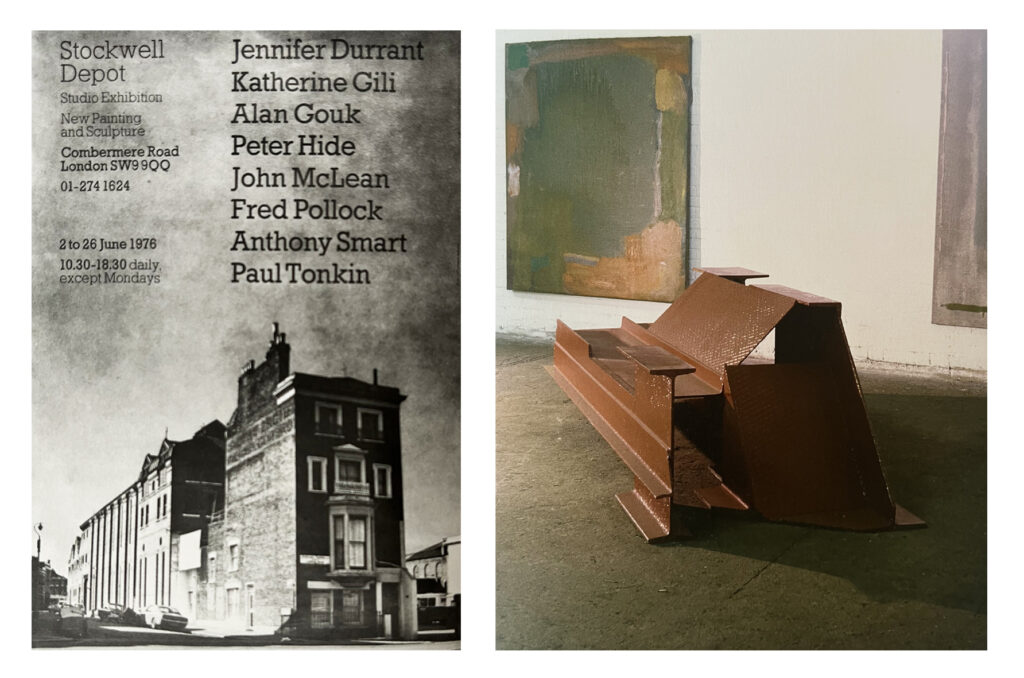
MD: Did you fight to keep it all going?
AG: Let me try to illustrate my answer with an anecdote. In 1979, Peter Hide and I realised that it was all falling apart- not on the sculpture side, the sculptors were all solid as a rock- but the painters were becoming more and more jealous and resentful of one another. Their bolshiness was being vented on one another; I can’t go into too much detail about it all, because it wouldn’t be fair to certain personalities. John McLean’s no longer with us, so there’s not a lot I want to say on that score, other than that we just didn’t get on, let’s put it that way. Anyway, Peter and I realised that it was all falling apart, so we put together a statement, a programme of commitment, if you like-
MD: A manifesto?
AG: Not so much a manifesto, more an agreement that stated that we were all working together, and so, if any one individual was approached by a gallery or a collector or a public body to buy a painting, then that artist would inform the other members of the group, and we would ask the potential buyer to look at everyone else’s work as well. We arranged a meeting at the Hole in the Wall, a pub in the arches at Waterloo, and prior to it, everyone had been posted a copy of the agreement for them to read and consider. Not all of the painters turned up to the meeting, but the ones that did- John McLean, Paul Tonkin, Geoff Rigden, all refused to sign. The sculptors all agreed; the painters all refused.
So, the 1979 Stockwell show was a group show of painters and sculptors, and for the first time we added outsiders in, who’d never shown with us before, including Mali Morris and Jeff Dellow amongst the painters, and Glynn Williams amongst the sculptors. Peter Hide asked a man called Peter Davies to write the catalogue introduction. I don’t know where Peter Hide had got him from, or where he came from, or why he thought it was a good idea to ask him in the first place; anyway, the essay Peter Davies supplied was a truly dreadful piece of writing, not just in stylistic terms, but also in terms of factual and typographic errors. I was furious.
A few months later, this same Peter Davies decided to curate a show in Poole, in Dorset, at a space called the Lemon Tree Gallery, or something like that; and he proceeded to do exactly what Peter Hide and myself had been fearful of, which was to invite some but not all of the Stockwell painters to exhibit. Of course, he didn’t ask me, because he’d heard that I’d been seething about his appalling writing…writing that continues to this day (laughter).
This was all confirmation of our worst fears: that some of the group were now going their own way. John McLean had always been bobbing along on the sidelines anyway, not really part of Stockwell, because his studio was separate from the rest, and because he and Peter Hide didn’t really get along; but now, everyone was pulling away and following their own course.
Well, I agree with what Patrick Jones has said: it’s a great shame that everything has broken apart. This is probably why Robin Greenwood’s whole project has taken off in the way it has, because there’s a need for that sort of thing; first his gallery, and then the Brancaster Chronicles, which, unfortunately, I’ve always said I didn’t want any part of, because I fundamentally disagree with privileging the internet over live exhibitions. I happen to think that one’s first view of a painting shouldn’t come via the web; one must go and see it in the flesh first. I also feel that the motives behind the Brancaster Chronicles were entirely promotional: they were all about getting a wider audience via the internet, which I feel is entirely wrong. I said I wanted nothing to do with it, and Tony Smart got very irate, because they wanted to video the whole process, and I argued that airing your dirty linen in public is not such a good idea. I think that it’s ended up with the videos being of greater importance than the shows; the publicity is all-important, the shows themselves are simply a ruse for getting the work onto the web. And the filming shifts the dynamic completely, from the timorous to the domineering. If the St. Martins forums had been video-ed, they would not have been the same. There would have been more grandstanding.
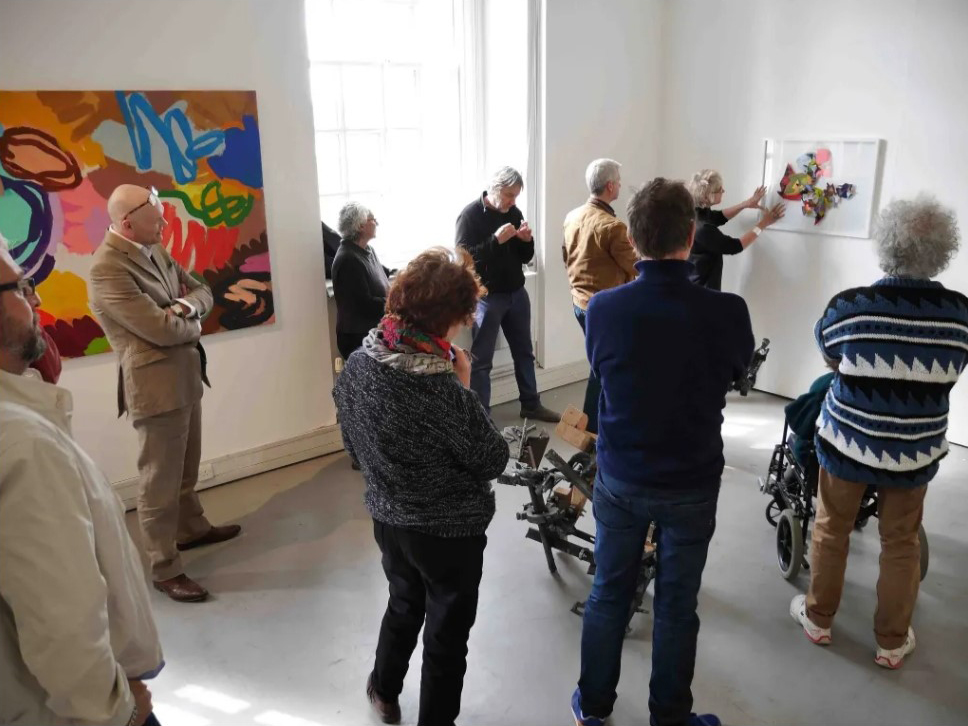
MD: My feeling about the Brancaster Chronicles– having participated in a few myself- is that they’ve got more in common with open studios than with exhibitions as such; and so I don’t personally find them problematic. If the videoing were to replace the live experience of the work- as you clearly feel it does- then no, it shouldn’t; but given how geographically spread out people are, and given how few opportunities there are to exhibit work-
AG: But most people just watch the video; they don’t go any further. For instance, there was the show put on in Greenwich a few years back9http://www.greenwichunigalleries.co.uk/brancaster-chronicles-in-greenwich 2017/: nobody went to it, it only existed for the night they were making the video of it. I went along a couple of days later, it was deserted, there was no-one there invigilating or greeting visitors. The few people I know of who went along later as well all said the same thing. It’s all a promotional exercise, and the work is secondary.
MD: I suppose I feel that we’ve all got to make our peace with digital reproduction in one way or another, because there’s no going backwards now, one is forced to have a social media presence, even if that’s merely the bare fact of owning a mobile phone. Once upon a time, I knew, and knew of, people who refused to own one. Who refuses now?
AG: I know. Pat, my wife, has put me up on Instagram, because everyone’s doing it, all of the time.
MD: I know, though, that it can’t continue the way it’s now going, because we’re approaching saturation point, and so I agree with you in that sense; but my own instinct as regards one’s work is that one has to get it out there, by fair means or foul.
AG: Of course. If you don’t exhibit, you don’t exist; but in my case, I really mean exhibit, as in have people come and stand in front of the physical work. A photograph, digital or otherwise, has never been and never will be a substitute. Photographs flatter to deceive: everything looks good on the internet.
MD: Anything backlit looks lovely, as a rule.
AG: I wish that there was a peer group for me to be a part of now. But all of it was torn apart by overweening personal ambition. Not that I’m putting us on the same level as the Abstract Expressionists…
MD Oh go on (laughter)…
AG: But the same thing happened to them. As soon as any of them started to get any kind of success, it was all daggers drawn: Clyfford Still claiming that he taught Rothko how to paint, Rothko claiming he taught Newman. I suppose in a way it’s all inevitable. I deeply, deeply regret the Stockwell split, and I fought hard against it; I dearly wished for us all to stay together.
MD: I sense from all that you’ve been saying that you do indeed harbour the strong instinct to move things along for everyone’s benefit, for the common good. To gather together and to promote and to help people..
AG: Patrick Heron did exactly the same thing. He lobbied on behalf of his painter friends; for all the thanks he got for it.
MD Let’s talk about the post-Stockwell years…
AG I see the Stockwell years as wilderness years, because I was trying to get out from under the influence of the paintings and painters I’d encountered when I’d been in New York, and subsequent to that. I’d gone for the messier side of Larry Poons’ work, and rejected post-painterly abstraction; I was trying to paint ‘brushily’, touching the whole canvas surface. If you take Morris Louis’ ‘Veils’, for instance, they come about via a process, and there’s no sense of the canvas being touched or brushed; the paint is a sort of phenomenon that simply happens. I was trying to get away from all of that, but not all of the others were- the Stockwell painters were far from being a unified group in terms of their attitudes. John McLean, for instance, was very strongly influenced by Ken Noland and by Jack Bush, all the way through the 1970s and into the 1980s.
I realised, after the Hayward, that I couldn’t go on doing the sort of paintings I was doing, which were kind of heaving, using things to squeegee the paint and scrape it around, edge to edge. I think they’re good paintings, but they lacked just exactly those qualities that I’d seen in Heron, the specificity of scale, the directness of colour; I felt I had to make a big change, and I started working on a smaller scale, in oils. At this time my studio was in Chiswick, in a narrow passageway that takes you down towards Island Records. it wasn’t much bigger than the room we’re in now, and the paintings each took up the entire wall, once they grew big again. But in 1981, 1982, 1983, I worked on a relatively small scale; I wanted to paint a more painterly sort of painting, but one that was tangible and specific. I started using broad wedge shapes, horizontal, overlapping. I had a joint show with Geoff Rigden, and although hardly anyone’s ever written about me, the best criticism came after that show, when a guy called Michael Billam described the paintings like this: ‘Alan Gouk’s paintings certainly don’t ingratiate themselves at first sight of their thickly applied paint surfaces, where the edges of marks rear up in spiky ragged ends, like waves rebounding from a harbour wall. I would guess that this quality is adventitious but stems from a strategy which allows Gouk to make decisive adjustments to the work in progress by knifing or scraping in solid swathes of colour of a predominantly horizontal or vertical orientation, as if Cezanne’s late deliberate brushstrokes were re-writ large, fat and juicy […] Gouk is ploughing an individual furrow.’10Billam, M., Artscribe no.39, 1982
And I thought, good God, is that what I’m doing? It’s a great description: it captures exactly the feeling the paintings have, of something that hits and spreads. But it should be noted: the ‘large, fat and juicy’ brushstrokes weren’t single strokes- they were multiple strokes that formed into a wedge.

MD: The first time I ever saw your work in the flesh was at the Riverside Studios in Hammersmith in 1987. I’d read about the show in ‘Time Out’, and I recognised your name from the Heron Barbican catalogue essay, but I had no clue at all about what sort of painting you made. So I went along, and I was very impressed; I’d not encountered painting like yours before, and the sheer horizontal extension of the canvasses was something new to me.
AG: By then, by the time of that show you’re talking about, I’d stopped using acrylics and switched to oils; I’d wanted to get away from the very clogged impasto I was getting with acrylic paints, but at the same time I wanted a firm surface. The solution, I felt, was to go for the sort of horizontal spread that you’re describing, so as to get away from the sort of thing I didn’t want; specifically, I wanted to avoid blocks, in the sorts of ways that Hoyland had been using them. I, like Hoyland, was working out of Hofmann, if you like; but in my case, out of Hofmann’s painterly side.
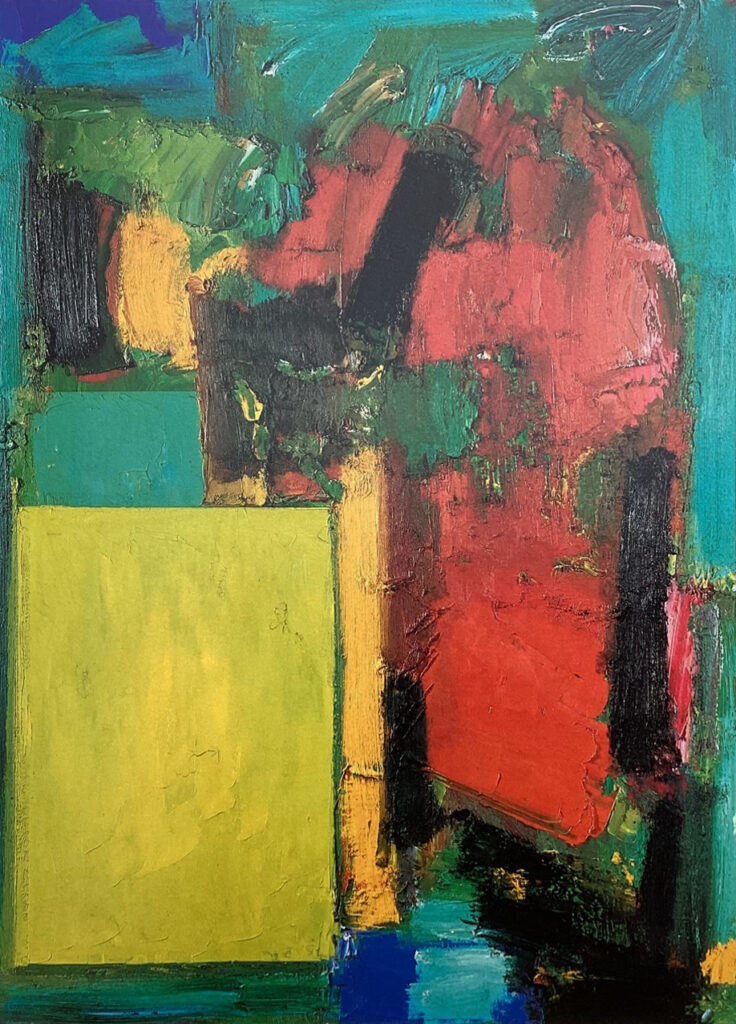
MD: What I liked about the work on show at the Riverside- apart from the colour, and the materiality of the paint- was something that I now understand Michael Billam picked up on as well, in the quote you’ve shared with me, to do with the harbour wall and the wave hitting it: there was a pitch and a roll to all of them, and a, what do you call it? a yaw in their rhythm, a feeling of twisting and pivoting around a vertical axis…
AG: Well, that’s how I got out of the Stockwell era, and into what followed it; and I would say that with those paintings and others from around the same time, I found my mature style. My work has been a kind of theme-and-variations around this ever since. I did find myself so strongly influenced by the Matisse/Picasso show at the Tate in 2002 that I adopted an approach based around use of thinner paint; but I’ve since returned to the concerns that we’ve just described. Let’s just say: if I hadn’t been painting like waves hitting a harbour wall before Michael Billam made the observation, I certainly was afterwards. It was a quite brilliant insight on his part.
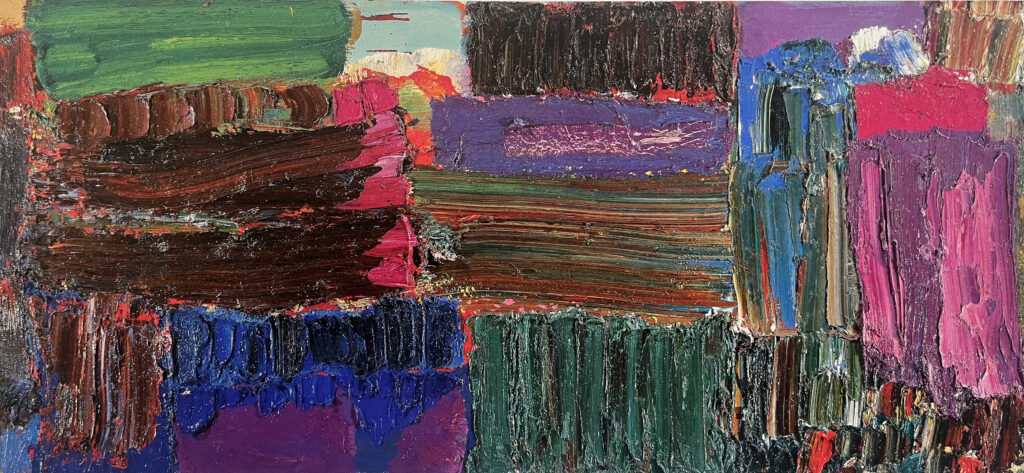
MD: I’d like us to talk now about the work that you made as you moved beyond Stockwell; from being part of a collective that had any sort of traction within the culture-
AG: Even though that collective, and what it stood for, was heavily criticised?
MD: Yes, but even so, it was being talked about, and noticed; it hadn’t at that point become marginalised.
AG: I would argue it was very much marginalised from its inception; we were outsiders all right, and nobody was interested, unlike how it went from the very beginning for Damian Hirst and his Goldsmiths cohort. The difference being, of course, that theirs was a very different kind of art, which swiftly became flavour-of-the-month with very little difficulty; that, and the fact that they knew how to promote and to strategise and to benefit from it.
MD: Well, it was post-Warhol art, wasn’t it? Made with a careful eye on marketing, and on what reproduces easily, and had an easily-apprehendable message, and carried a hefty dose of sensationalism; as the title of the YBA’s RA show, ‘Sensation’, came clean about…
Anyway, the book, ‘Principle, Appearance, Style’ came out in 2008, correct? I feel like I have some grasp of the work you’ve been making since that milestone, but it hasn’t all been rounded up in published form…
AG: Funnily enough, there’s as much work been made since that book as there was gathered and reproduced in it; I’ve done an awful lot of work since then.
MD: Am I right in thinking that you’ve been deploying plasterer’s tools, or something similar, to apply the paint to the recent big paintings? To produce those thick wodges and wedges of pigment?
AG: No; all these recent big paintings you’ve seen, they’re all done purely with the brush…
MD: Big old brushes, then…
AG : Well, they all employ multiple techniques, multiple ways of putting the paint on; and what I often do is squeeze the paint onto a surface like that [holds up large hardbacked book] and apply it to the canvas. And I’m not the first painter to paint in this way.
MD: Of course you’re not. Your nemesis, Gerhard Richter, to name but one, has been squeegeeing paint on for decades now…
AG: Yes, and this way of painting, that he’s made a name for himself doing, what he’s doing is repeating a format that was all the rage in the late 1970s: trowelling the paint on. And if you look here and here in ‘Principle, Appearance, Style’ [opens copy of book] at ‘Wild Orchid’ of 1978, and ‘In the Wake of the Plough’ of 1979, there I am, doing it…
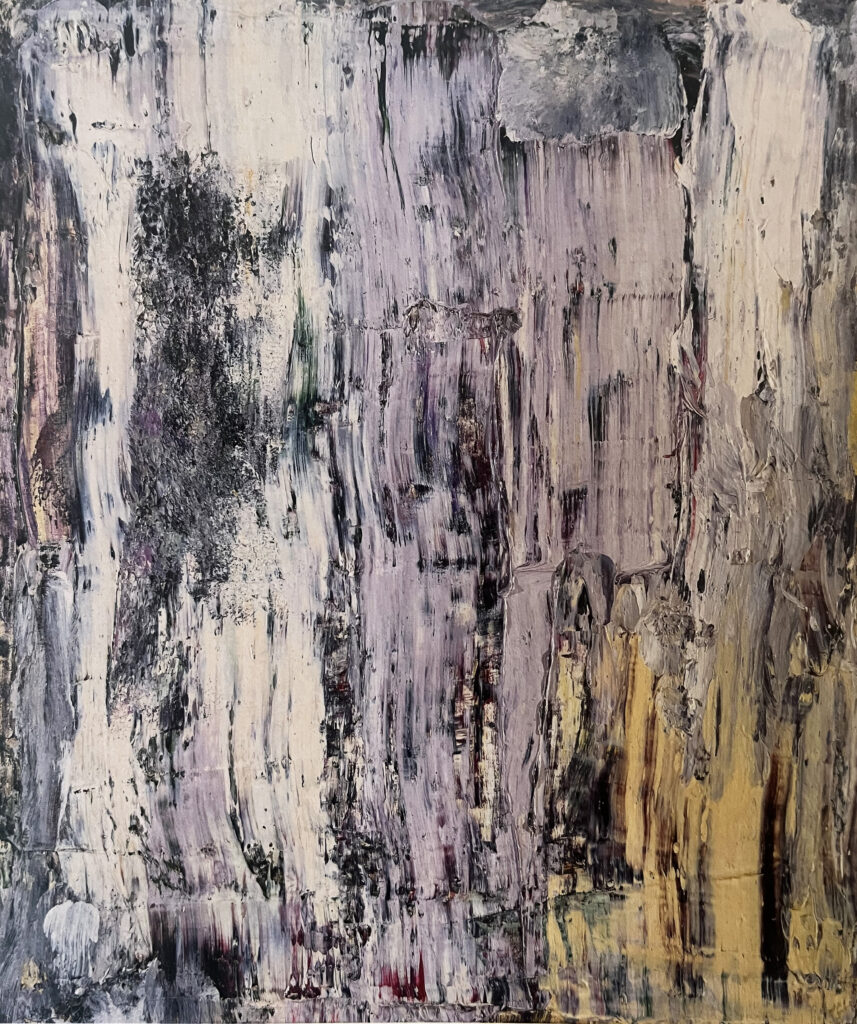
MD: And what implement were you using at the time, to get that much pigment on, and so thick?
AG: A coal shovel (laughter). And here I am, doing it in 1978. Richter started squeegeeing about fifteen years later…
The reason I made those two paintings, and others like them, was that I had been influenced by both Poons and Olitski. Greenberg had said something to me about going right to the edge, rather than the painting containing something, as it were; exactly the opposite advice to what he’d given Patrick Heron, twenty years previously. This is what I mean when I refer to that Stockwell period as the wilderness years: every time Greenberg came over to the UK, Tony Caro would bring him round to the Stockwell Depot and get him to crit our painting; but he only ever said a few words-
MD: How many visits did he make?
AG: I’m not sure; there were two or three visits that I was aware of; no, more, actually, because he came several times solely to view sculpture, and he only came to view paintings twice, in and around the times when the annual Stockwell shows were on…Anyway, my point is, these are wilderness years for me, because I kept trying to get away from all this influence he was bringing to bear, and it kept coming back at me. So in one sense, I was very fortunate not to be chosen for the Hayward Annual in 1980, which Hoyland curated- an episode I’ll elaborate on- because it meant I had a kind of clean break, and I was able to change course.
MD: Do you think that if you’ve stayed within that Stockwell circle of influence, you’d have kept with the ‘house style’?
AG: Well, no, all I can say with certainty is in a sense a negative, that I wouldn’t have developed in the way I subsequently did. I don’t see there as having been a ‘house style’. What characterised my paintings was a desire to bury post-painterly abstraction, which can’t be said of John McLean, or of Fred Pollock, for that matter.

MD: I’ve been looking at these various catalogues of your work from the last decade or more- such as the catalogue for the group show that Robin Greenwood brought together under the banner ‘High-abstract’11‘High-abstract’, Poussin Gallery exhibition catalogue, London 2011 …and what strikes me about a great deal of the work made by you in these catalogues is that it feels almost tailor-made to fit a definition I found in Hans Hofmann’s writings, where he says
‘Out of a feeling of depth, a sense of movement develops itself. There are movements that swing into the depth of space, and there are movements which swing out of the depths of space. Every movement in space releases a counter-movement in space. Movement and counter-movement produce tension, and tension produces rhythm.’
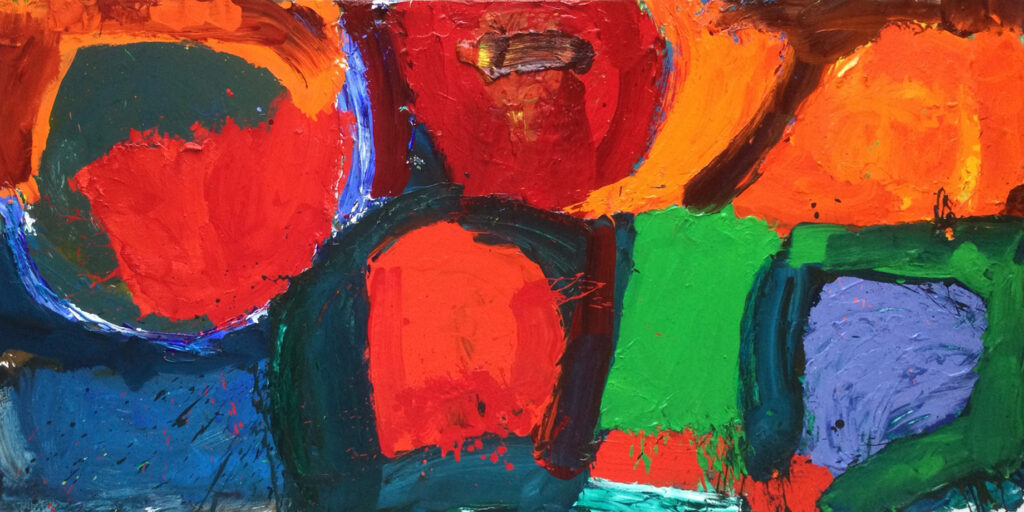
I feel that is very apt, especially in relation to your last show at the Hampstead School of Art, where you seemed to have arrived at a combination of what in one way has to be seen as a kind of stark simplicity, together with this extreme richness of the colour, and extreme physicality of the material; and looking at the paintings, I had a strong sense of your working on them, establishing these swinging, almost metronomic movements, which seems to me to be the principal way in which you take possession of the long horizontal. Do you recognise this sort of description?
AG: Well, there are so many things in painting that one can’t do, because people such as Hans Hofmann have already done them, they’ve been there before, and beyond them, people such as Hoyland have developed the things they’ve done in particular ways; and with Hoyland, once he’d seen the opportunities in Miro, began to use drawing and shapes in ways he hadn’t done before. I have said elsewhere that he didn’t so much assimilate Miro as assault him, because you can’t assimilate everything about a painter, that simply leads to imitation. Because of the past precedent of another painter, and because of the anxiety of influence, there are certain things one just can’t do; and one of the things I can’t do is figure/ground, where you have an open, transparent space in which shapes and colours are floating or deposited. It’s too Hofmannesque, if you like.
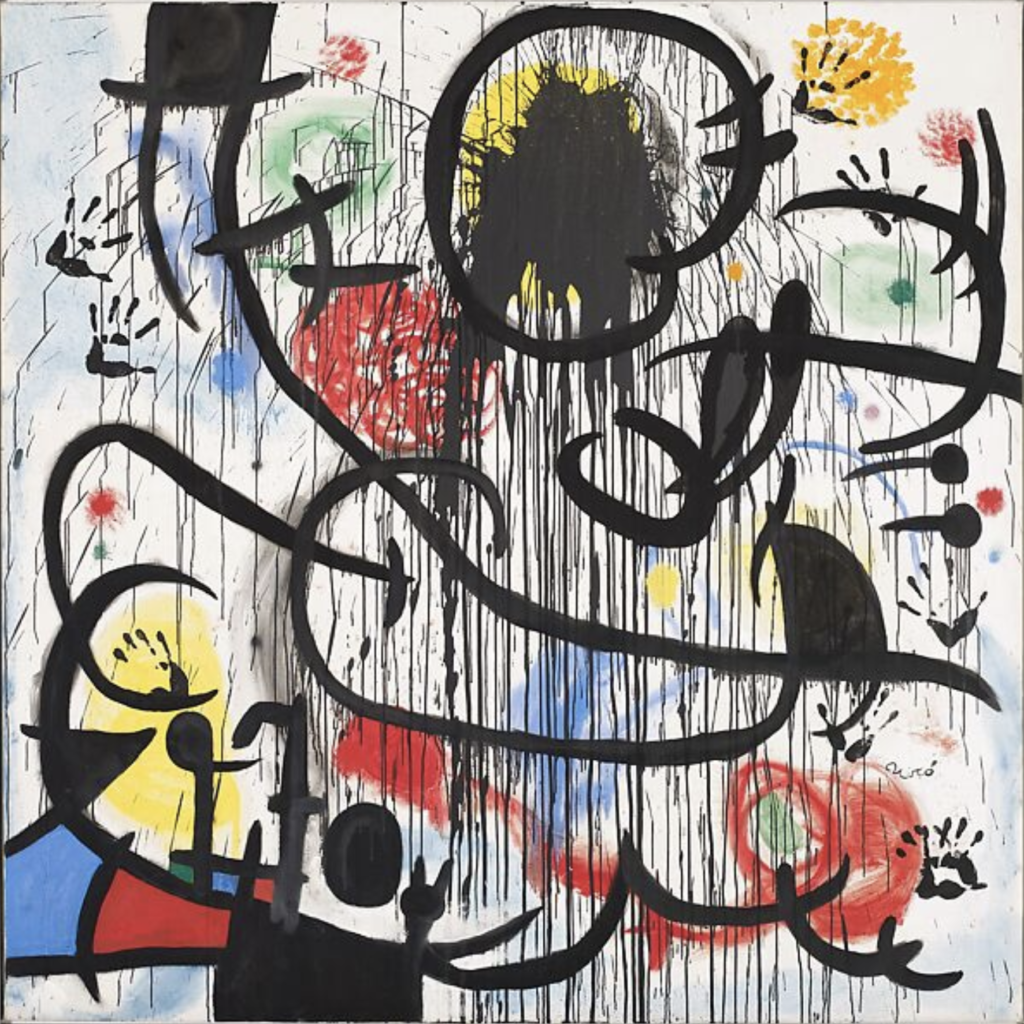
MD: I remember coming across an essay on Hoyland written by Bryan Robertson in an old edition of Studio International from the late 1960s, in which he says that a danger Hoyland was working hard to avoid was just that trap of figure/ground, of placing a form in the painting that read too much like a thing in a place, like a sort of abstract ‘cow’ grazing in a colour ‘field’, or words to that effect…I can see this sort of aversion at work in the paintings you’re making now, you’re taking enormous pains not to let anything ‘drop back’ into fictive depth.
AG: Yes, that’s how it’s been for me for a long time now.
Clement Greenberg wrote a very good book on Miro: in it, he says that Miro’s art is inimitable because it’s so synthetic, because he’s absorbed the influence of so many artists, particularly Klee, but also Kandinsky, the cubists, and the surrealists. But the essential thing that has to be understood about Miro is that he energises the ground of the painting; he almost renders it as a magnetic field. It’s not a passive container. And this was the thing that Heron, too, so abhorred: the passive, lifeless ground.
Hoyland saw this in Miro: that the grounds of the paintings were electric, pulsing with life, alive with possibilities, and the best of Hoyland’s paintings were the big squarish ones where the entire surface was spattered, almost like the sky at night, in which he was rendering the whole painting active before beginning to draw his big shapes and whorls into it. This side of Hoyland comes from Miro, but is a development of it. And of course, Miro himself in his later years was responding to what the Abstract Expressionists, especially Gottlieb, had made of his earlier ‘magical fields’. And so it goes around.
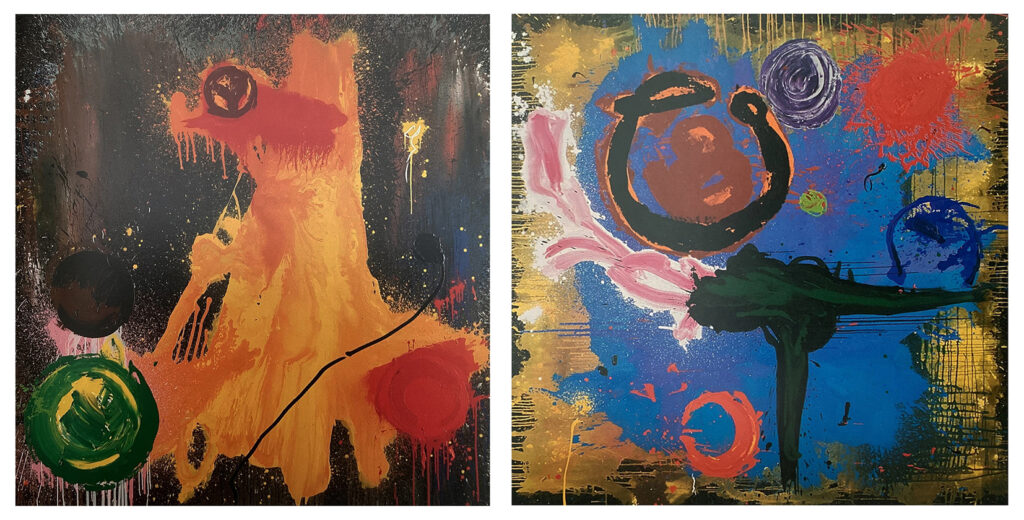
So, where am I? I can’t do Hofmann’s transparent fields and I can’t do Hoyland’s spattered ones. If I did, it would be obviously derivative. My painting has made its way to a more robust, physically touched surface; but this isn’t a recent development, it’s been going on for a long while in various forms.
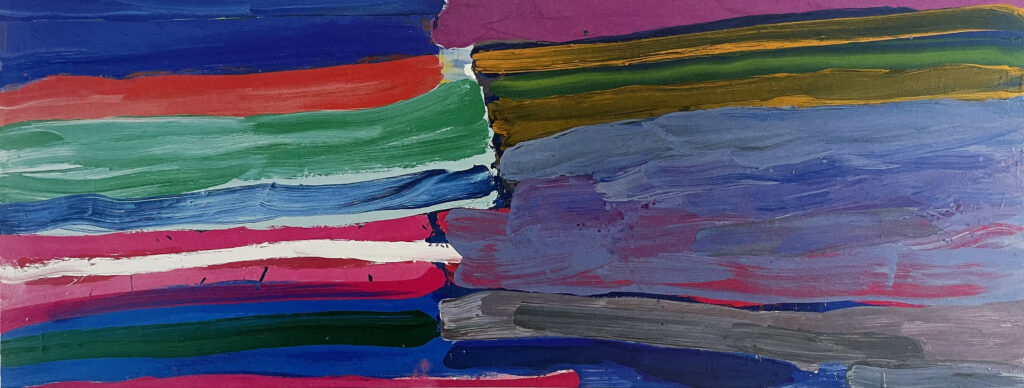
MD: It’s now- what?- thirty-five years since the show at the Riverside Studios where I first encountered you work; and this robustness you talk about was very much evident to me then, was in fact the most striking thing about the work for me.
It interests me greatly, you talking about what you can’t do, and citing the artists that have done it. In a way, you’re offering the same argument, in explaining why there are things you can’t do, that so many people offer now for not being able to do anything; for not being able to formulate any kind of fresh statement at all in paint.
AG: Well, there’s something marvellous that Greenberg said: that the painter’s world is one of ‘confined surprise’. Meaning, it’s not surprise in the sense of an elephant’s trunk suddenly emerging out of the canvas, or anything like that; but that, within certain formal and stylistic limits, there’s an element of surprise. It’s to do with somehow keeping the painterly qualities of good painting going.
It doesn’t matter that there are people that see the entirety of painting as dead; it’s not. As long as people come into a gallery, see a painting, and wish to emulate its level of achievement, it’s going to remain alive; and my art is consolidatory, in that sense, it tries to keep the succulent life of painting going.
MD: There’s the notion- I have it in my head that it was first put forward by WH Auden, but I couldn’t swear to it- that in the history of any art form there are the explorers, and then the colonizers; and perhaps we can see visual art now in those terms, that there is nothing more for the explorers to do?
AG Well, yes, at the moment I think that is true, because there have been so many explorations in so many different directions, and most of them have led to a dissipation of painting’s potential. To my mind, now is a time for consolidation of those best virtues that painting has: and that’s what I’m about. Whether or not people now think painting is dead means absolutely nothing to me; it doesn’t bother me in the slightest. And that’s why I can’t really understand what the fuss of the last thirty or forty years has been about: commentators like Waldemar Januszczak declaiming on the death of painting on BBC2’s ‘Late Show’ whilst making a tidy living talking endlessly about the very thing he’s given up on as dead…he can say whatever he likes, it has absolutely no effect on me.
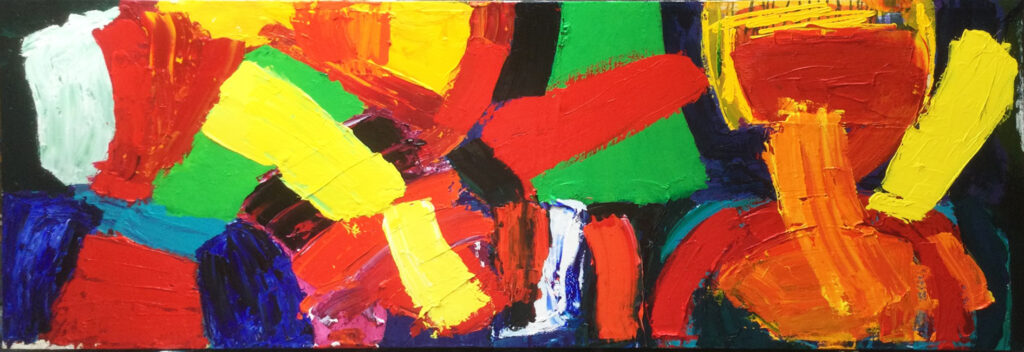
Hoyland, Heron, and the Hayward
AG: I think it’s worth my talking about John Hoyland and the 1980 Hayward Annual, and the events that led up to that whole episode.
I’d been friendly with John Hoyland when I’d been at the British Council, and afterwards; and he’d been interested in the whole shaped canvas thing, and he used to come and see me when I was making them. The British Council selected Hoyland to show at the Sao Paolo Biennale in 1969.
Anyway, I was close to him all through those years; and in 1974 I wrote an article, ‘Principle, Appearance, Style’ (a title I also used for my monograph12‘Principle, Appearance, Style: Alan Gouk, A Career Survey’, Poussin Gallery, London 2008 which was a wide-ranging, discursive essay about the problems of abstraction and representation, and the borderlines between them; it talked about Pollock, Hofmann, Noland, and so on. It was discursive, critical, and I quoted Walter Darby Bannard several times. But it just so happened that while I was writing it, the Garage13The Garage was an enterprise started by Tony Caro and Kasmin to give our generation a leg up. They financed it and appointed two young bloods, Anthony Stokes and Martin Atwood, to run it. It ran for about two years. Situated in Covent Garden on the corner of Earlham St and Neal St, it later became Smiths Galleries, a hire space. They showed Stephanie Bergman and Fred Pollock early on; theirs was the show I reviewed in ‘Principle, Appearance, Style’. However, they drifted away from the Stockwell artists into something more cool and trendy had opened, and they offered a show to Fred Pollock, who was a friend of mine; at the time, he was making paintings of horizontal bands, influenced by Noland and Jack Bush. I took the opportunity to review Fred’s show, and I praised it; but then I took a swipe at Hoyland, who had a show just opened at Waddington galleries- a group show, and Hoyland had a painting in it, alongside a painting by Hofmann. I compared the two, in terms that disparaged the Hoyland.
MD: This was what- 1974, wasn’t it? So Hoyland was using a lot of blancmange-y colour, wasn’t he? Pinks and buffs and pale mauves and so on…
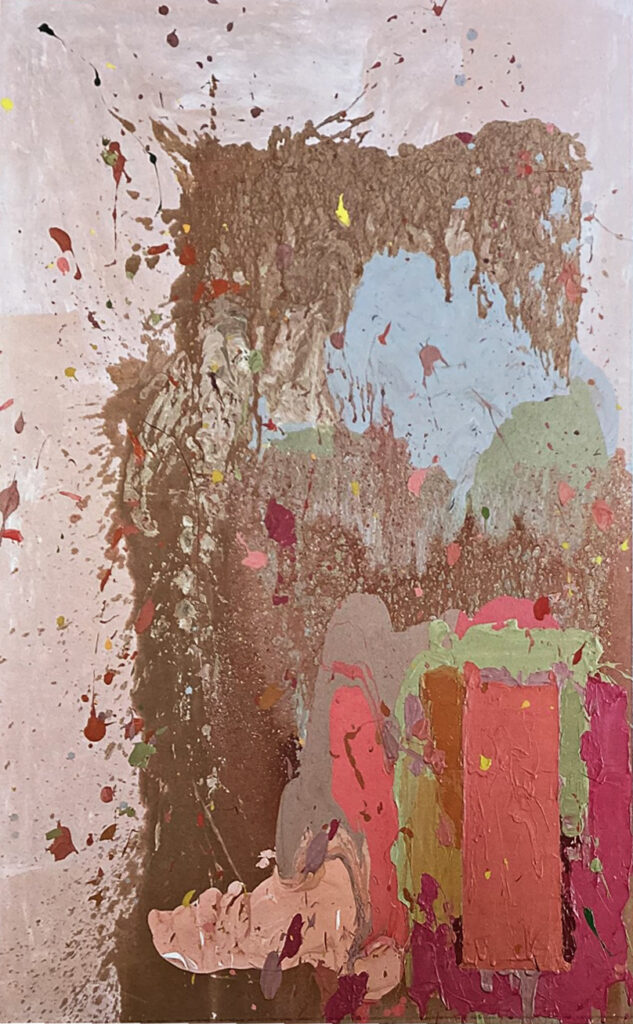
AG: Yes, exactly. What I described as ‘Pastels and fluorescent, high-keyed colour’. And I said that these colour choices just didn’t match up to the Hofmann. Which was true, I would argue; but my problem is that I seem to feel that criticism is an objective pursuit, and that as such, people won’t take it personally; they’ll take it on board, and either agree or disagree, but they won’t take it to heart.
MD: This is a charmingly quaint view of yours, isn’t it? (laughter)
AG: Ridiculous, I know. And before I wrote about Hoyland, Caro had already said to me, ‘Whatever you do, don’t write about your contemporaries.’
MD: And has it ever cut the other way, where someone has been so disparaging about your work that you’ve felt compelled to cut off all contact?
AG: Not to the point where I’ve felt the need to cut off contact, no; but bear in mind that hardly anyone has ever bothered to write anything about me… (laughter)
MD: Well, the good news is, that state of affairs is finally about to change… (laughter)
AG: The fact is, it’s not only naïve of me, it’s stupid of me as well, imagining that people aren’t going to take criticism personally. But that, then, had been my view: that somehow, criticism was some sort of objective science.
So, come the 1980 Hayward Annual, was I going to be in it? When my 1974 article had come out, I was still on friendly terms with Hoyland; and sometime in the years in between, I bumped into him on the street one day, and he said to me, in an ominous tone, ‘You’ve no idea of the power of the written word.’ He then went on to say ‘I had an opening in Milan, at the Galleria della Navilia, and someone came into the gallery brandishing the Studio International article and saying, “Look, look what they’re saying about you in London.”’
So, in 1980, Hoyland, along with Tim Hilton- whom I’d also fallen out with for unrelated reasons- went round the studios looking at people’s work. Amongst others, they chose Patrick Jones, and Frank Bowling; but I, however, was emphatically not destined to be chosen. I learned from friends that Hoyland had been going round asking them, ‘What do you think of Alan Gouk? he’s a paranoid schizophrenic, isn’t he?’
MD: He really hadn’t taken your criticism at all well…
AG: And none of the people he contacted stuck up for me! because they were all so fucking keen to be in the exhibition themselves. In the catalogue for the show, Tim Hilton wrote up the various artists’ work in such a way that pretty much all reference to me was completely excluded, even in the biographical notes; in the biographies of those artists I’d exhibited with, I’m only mentioned in Geoff Rigden’s. Everyone else excised me. Oh, and I should mention that while I was at it, I managed to fall out with John Golding as well, because while I was writing about Hoyland, I sent a bit of a barb Golding’s way too: he was exhibiting at the same time, and I said that I thought his paintings were somewhat anaemic. Well, compared to Fred Pollock’s, they were. I didn’t say ‘anaemic’ in so many words; but that was the gist of it. Unfortunate, considering that John Golding was an eminence grise at the Arts Council, and later a Tate trustee.
MD: Not to mention, a great authority on cubism…
AG: Yes, and I liked him as well. I’ve tried to apologise since, by saying to him, I’m sorry, you just happened to be in the firing line…but the fact remains, I made enemies of him and Hoyland in one fell swoop.
Anyway, 1980 was also the year that I went again to New York, and saw this show that Kenworth Moffett had put together.14Kenworth Moffett, head curator at the Boston Museum, came to London to select for a show of our generation of painters to be held at the Andre Emmerich Gallery, NY., also including Americans and Canadians. He chose John McLean, Jennifer Durrant and Douglas Abercrombie. (Greenberg said he had chosen wrongly). I happened to be in New York at the time of the opening for other reasons, and was able to attend. I stayed away from the Hayward Annual until very near the end of its run, once I’d returned from my New York trip; and I viewed it with the scales freshly fallen from my eyes, seeing that a lot of the things that we’d all been doing were not really leading anywhere. The show had garnered generally pretty poor press; and though it was intended as the summation of something, it actually felt like an ending. It wasn’t the end of painting, nor was it the end of modernism, but it was the end of a particular kind of lyrical abstraction. At the entrance to the show there was a group of works by older figures, one work apiece; and the one that stood out for me was this Patrick Heron painting, ‘Tall Brown’ of 1959, with these white and beige brushmarks, and a few shapes. What I admired about it was that amid all the lyrical flourishes and painterly gestures on show in the other paintings, it had a matter-of-factness, a plainness of statement, as Andrew Wilson said in his very good essay in the catalogue for the 2018 Heron retrospective.15‘Patrick Heron and American-type Painting’, essay in ‘Patrick Heron’, ed. Wilson, A., Pavilion Books UK 2018
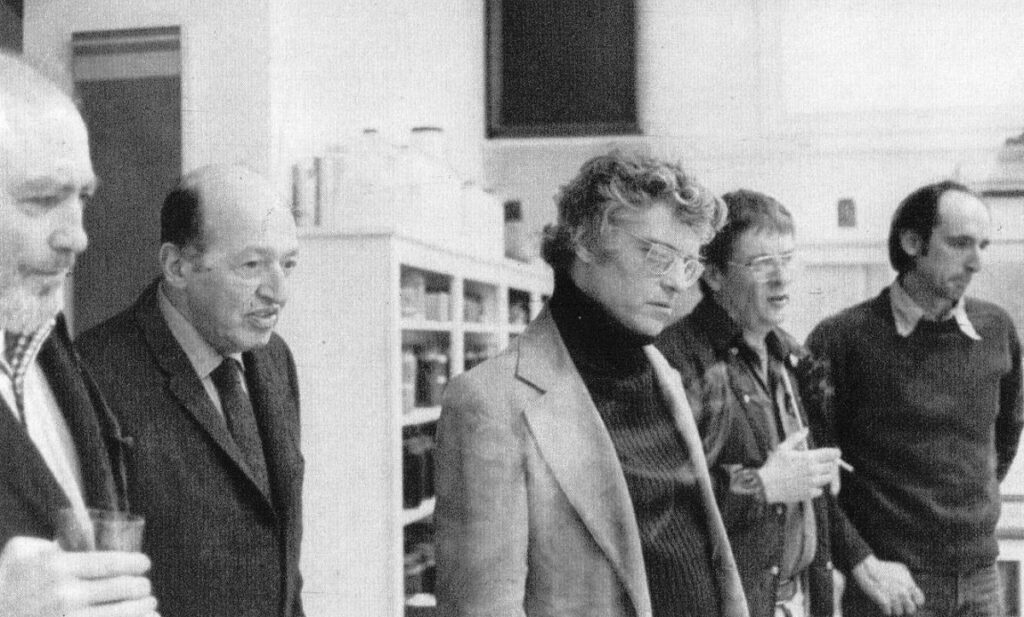
I’ve written four major pieces on Patrick Heron, and I’d thought I’d write a fifth after his retrospective; but I read Andrew Wilson’s catalogue essay and I thought, there’s no point, he’s said it all, really. He had the advantage of access to letters between Heron and Clement Greenberg that I’d never seen or even known about.
The phrase Wilson used about Heron was ‘explicitness of scale’– and that’s what abstract painting should be about, not amorphous, floating, cloudy atmospherics. A frankness in the use of scale.

But in 1980, it was seeing Heron’s ‘Tall Brown’ in the Hayward that made me decide to write about him. James Faure Walker decided to theme two editions of ‘Artscribe’ around the art of the 1950s, and I was on the editorial board at that time, alongside Matthew Collings and Stuart Morgan and various other people; and they asked, who wants to get involved in this? And I said I’d like to write about Heron in the 1950s- although the piece actually strayed into the 1960s as well- and meanwhile Adrian Lewis undertook to write a very thorough history of British painting leading up to the 1950s.
And so my friendship with Heron, which had begun back in my British Council days, was resumed then; and in order to write about him, I had to go and meet him in his penthouse flat in Earl’s Court. At that time, he still had this bee in his bonnet that had been there for decades, this running dispute with Clement Greenberg over the origins of abstraction; and I was treated to all these anecdotes that were very unflattering towards Greenberg. We had a long session of talk, and gradually I put the piece together, and when I’d written it- which took quite a while, because I had to go and view all his paintings, which were in storage- I warned him that it wasn’t going to be a puff, it was going to be a work of serious criticism, and was that okay? And he said yes, because, to be frank, he’d never had anything like my piece written about him. Alright, he’d had stuff written about him by Alan Bowness, but that was more art-historical, rather than criticism as such; but Heron was an autodidact, and he’d never come up against someone intellectually aggressive. I’d realised that it wasn’t enough simply to talk about the paintings, I had to relate them to his ideas and to his own writings on painting. So all in all, it was quite a major undertaking; and when I’d written it, I had to go back for more sessions and go through it with him word by word, and after every third word he’d stop and go off on another anecdote. A bit like what I’ve been doing here (laughter)…
MD: It’s my fault, I’ve been encouraging you (laughter)…
AG: We spent days and days on the first part, and eventually I’d had enough, and I had to say, look, I’m going to have to go and do the second part on my own, which I did.
MD: Presumably these essays of yours served as the springboard for the essay you wrote for Heron’s 1985 Barbican show catalogue?
AG: Yes. Later, I had him along to talk to St Martins students in the late 1980s- and he started out by saying that the UK’s two best writers on art were both in the room; meaning him and me. Well, he would say that, wouldn’t he? And of course, I was very pleased about that.
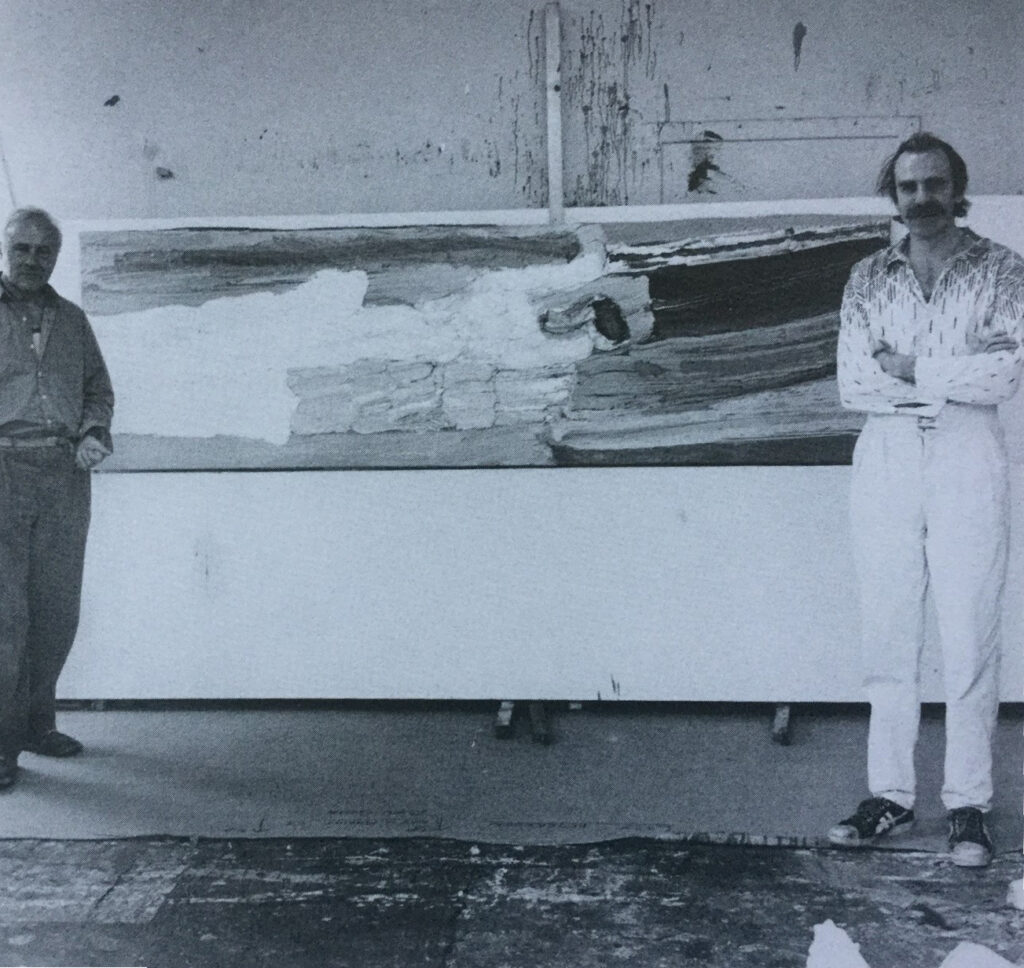
Once Hoyland had got his revenge by omitting me from the Hayward ’80, we got back onto a fairly amicable footing. When he curated the 1988 Tate show of Hofmann’s paintings, he asked me to participate. A group of us were featured in a ‘constructed’ discussion panel in the catalogue: Hoyland couldn’t manage to write the bloody catalogue essay himself, so he interviewed Tony and Sheila Caro, Basil Beattie, Fred Pollock and myself all separately, one-on-one like we’re doing now, and asked for our thoughts on Hofmann, and contributed his own; his being that Hofmann had been influenced by Nicolas de Stäel. I pointed out that although there was an affinity, Hofmann and de Stäel were actually moving in different directions, de Stäel towards figuration, Hofmann away from it. And once we’d all given our tuppence worth, Hoyland cobbled it all together to make it read as if we’d all met for a group discussion.
MD: Well, he fooled me (laughter).
AG: And since it looks as though we’d all been together, there are various kinds of silliness in it; for example, I appear to say to everyone that sculptors couldn’t understand certain aspects of painting- a remark which I would never have made, had Caro actually been in the room at the time (laughter).
MD: Yes, and I seem to recall Caro being very dismissive of Rothko’s paintings- calling their colour effects ‘that awful bloody cloud’. And of course, I was surprised, reading this, to find that no-one came to Rothko’s defence-
AG For the simple reason we weren’t there (laughter).
MD: At last, it’s all becoming clear (laughter).
AG: In actual fact, though, I did speak up for Rothko; Hoyland started calling Rothko’s work formulaic, signature-style painting, or something like that. And I responded, not if you really look. So that exchange was genuine, because it was between Hoyland and me; but anything between Caro and myself in that ‘discussion’ simply didn’t happen.
Well, anyway, I spent time at Hoyland’s Smithfield flat, making the recording; and it was all very cordial. I looked at some of his paintings he’d hung there, and I said ‘That’s a good painting’, and ‘that’s a good painting…’ Nevertheless, he wasn’t the kind of guy to forgive and forget. He made a career out of bad-mouthing everyone; that’s just how he operated. I’ll give you an example: there was an exhibition of Albert Irvin’s work up in Smithfield, just near where he lived, and we met there, and we talked; and I’d had no idea how old Bert Irvin really was, but he was in great shape; and I told Hoyland ‘I thought he belonged to your generation, born in the 1930s, but in fact he was born in 1920.’ And Hoyland said, ‘If you want to know how old Bert is, have a look at his wife.’ And that was just Hoyland. He did that to everybody.
MD: One gets the cleaned-up, sanitised version of Hoyland coming through from all the anecdotes and descriptions given by people who interviewed him, and hung with him; and I’ve often suspected the joyous, celebratory, life-loving angle gets overplayed, and that in fact he was a far more complicated, far darker character…
AG: He was very funny; but it was always barbed, always at someone else’s expense. I heard that very few people actually went to his funeral, because he’d made so many enemies over the years. You couldn’t help but like Hoyland, because he was so much larger than life, and so amusing; but he could only amuse by putting other people down, which he did, constantly.
MD: He’s impressive in the famous ‘Arena’ documentary from 1979, ‘Six Days in September’, in which he’s filmed working on one of the paintings that ended up in his 1979 Serpentine Gallery show. We see him making his first moves, drenching the whole canvas with thinned acrylic washes, and then doing all sorts to it…but while he’s working away on it, he’s talking, and he comes across as highly articulate in his ruminations on the painting process.
AG: I’ve seen the beginning of that film, when the painting isn’t going very well…there’s that thing that Matthew Smith said, that ‘it is the greatest immorality in art to try to finish what is badly begun.’ Hoyland’s painting in the film is an example of that: there’s something clunky and forced about the way he moves from one stage to the next. We all do it; I’ve done it myself, many times.
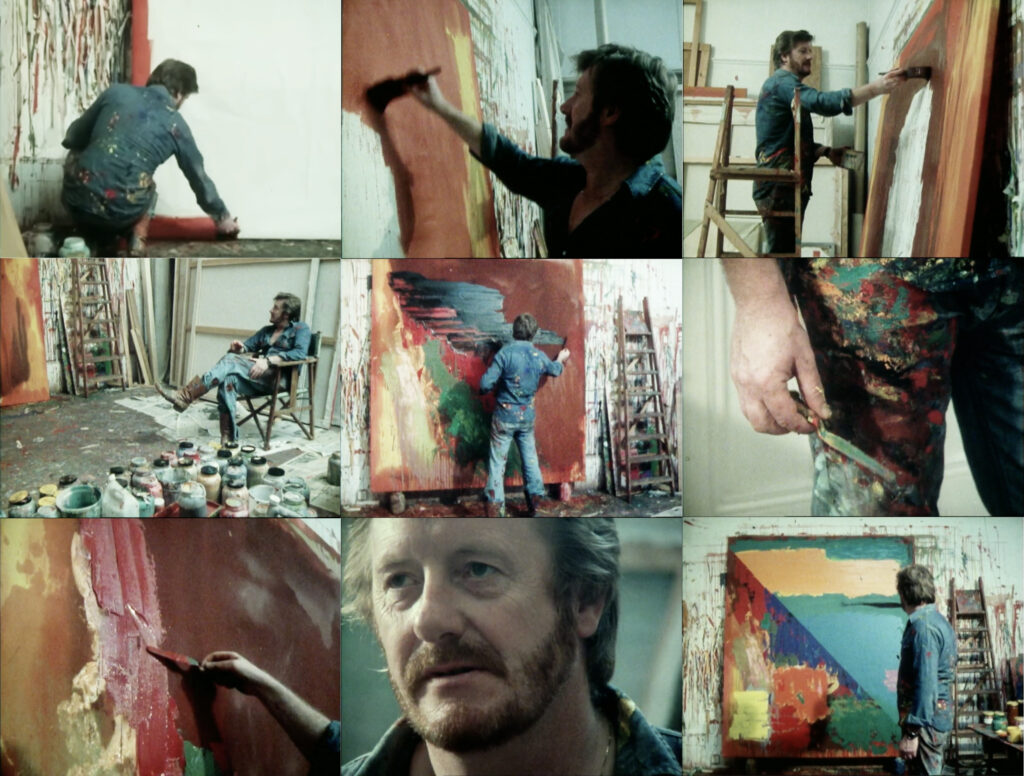
He begins by scrubbing paint over the entire surface (as I do too), but perhaps because he is being filmed, it ends up as an all-over brown mess. That’s day one. The next day he comes in and begins to load the canvas with shapes and moves that have been successful in the past, but there’s no flow, no rhythmic connection with the impulse of day one.
Next stage, he begins to work it up by superimposing a mosaic of colour patches, loading the canvas with paint, but again with no flow, and it’s formulaic in outcome, even when strong in colour, as his work sometimes is. In my view there should be a continuous rhythmic development from initial impulse to final image, an ‘easy give and take’(as Pollock described it), call and response, ‘impulse and echo’ (Hofmann), from one stage to another. ‘Surge and undertow’, I’ve called it, not meaning a mimetic naturalistic urge, but a continuous physical engagement from the first burst, respecting its initial character and following through.
MD: I’m not crazy about that painting, either; but I do think he comes across well…
AG: Oh yes! He comes across well because he was brilliant when talking about painting, he had a great turn of phrase, and a great store of one-liners; that’s why I was puzzled that he didn’t feel able to write the Hofmann catalogue essay himself. I just couldn’t figure it out, because he always had plenty to say. There was a needle to Hoyland, though, once the talk turned to careers and rivalries. In fact, I never ever heard him say a good word about anybody (laughter).
On Art Criticism
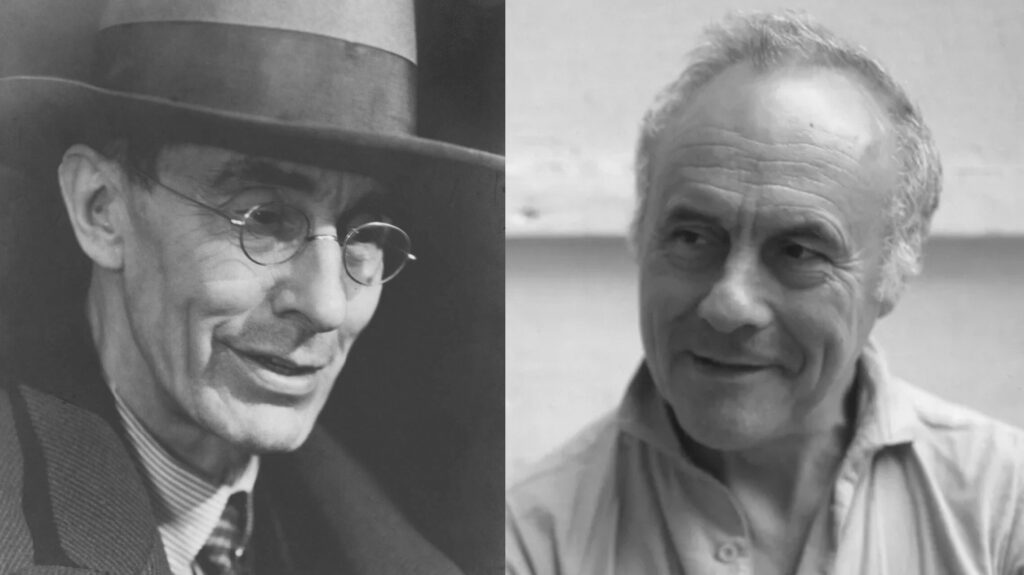
AG: I’ve written a lot over the years, mostly about other painters, both colleagues and friends; as well as criticism, of course, which has been more abrasive. The point is, if you take someone like Patrick Heron, probably the best writer on art since Roger Fry, or Fry himself, or anyone good in between, none of them had the slightest influence on moving the dial in terms of the public’s appreciation of British art, and of formal values in painting; they might as well have not bothered, because people are far more interested in the anecdotal, in the private lives of artists, of their relations, sexual or otherwise, with their subjects, than they are in the substance of the work. This is why the PreRaphaelites are so enduringly popular- there are so many stories woven around them. And it explains too the enduring appeal of someone like Sister Wendy Beckett, standing in front of a Renaissance diptych and saying, ‘St Agnes is weeping in this scene because…’ and you feel like shouting at the television, that’s not St Agnes, that’s a model that the artist has painted, and not particularly well at that…the narrative, the theatricality, they come first; and of course, the artist’s lifestyle, romantic and excessive and headline-grabbing.
So, a writer like Fry has had next to no influence outside of academia, where he is still highly rated; and Heron, who, in terms of his ability to open one’s eyes to what was really going on in a painting, was a far better writer than Greenberg, whose writing is schematic, and preoccupied with ranking people, and declaring which periods of their work were good, and which bad. Greenberg is good in rare circumstances, such as his writing on Clyfford Still, which came out of his love/hate relationship with the painting.
When Heron had his 1996 Tate retrospective, Lucian Freud was given a room at the Tate at the same time. John McEwan wrote an article entitled ‘The King and the Court Jester’: the King being Freud, the court jester being Heron. Heron, to him, was essentially frivolous, decorative. This sort of thinking is what one comes up against, all the time.
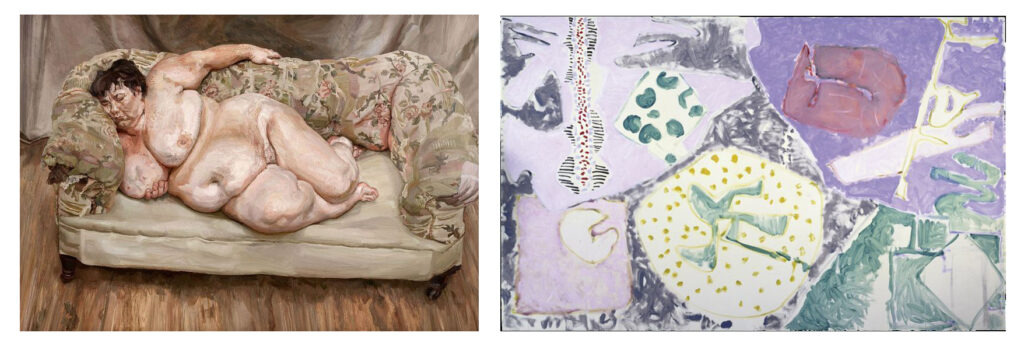
I’ve written a substantial body of work, covering these topics, and like Fry, like Heron, I might as well have not bothered, because none of it has had any influence whatsoever.
MD: To paraphrase Harold Bloom, you could describe what you feel as the anxiety of a lack of influence? (laughter) It’s understandable that you describe things in these sorts of terms; I recognise the frustration you obviously feel, and that’s what has prompted me to ask you about your sense, if any, of a peer group, of a network of artists or critics that you might derive a sense of fellowship or support from; and I wonder, too, about the feelings of isolation that must derive from holding a point of view that seems to have very little traction now…
AG: Well, I’m going to try to resist the temptation to launch into a rant about the state of the art world. But the fact is, I hardly ever go to exhibitions now, because there’s so very little that I want to see. Even the Cezanne exhibition that’s at Tate now, I’m not going to go and see that, because I’ve seen so many Cezanne exhibitions, and written about them, I don’t need to keep seeing his work.
MD: I’m surprised to hear you say that; because I always think, with painting of that quality, you can never see too much of it; I’m reminded of that exchange between- who was it? Emile Bernard?- and someone who’d criticised one of the arms of a figure in a Cezanne portrait for being disproportionately long; to which Bernard replied, an arm painted that beautifully could never be too long…but anyway, I take your point. I loved the show; but I haven’t seen any other big retrospectives of his work, and so for me, the experience felt fresh.
AG: The fact is, I have to husband my resources carefully now. The last time I was up in London was to attend the opening of my own show at the HSoA. I don’t feel like there’s anything I need to see; but no, I don’t feel in the least bit lonely, in terms of opinions I might hold.
MD: You acknowledge the truth, or the partial truth, of the presence of what Heron called ‘intellectual aggression’ in your writing…
AG: I don’t know why I do it! (laughter). I don’t know what gets into me. I said to Sam Cornish, I thought it might be my Northern-Irish nonconformist background…do you remember Tom Paulin?

MD: I do indeed: the poet/critic, on the BBC’s ‘Late Show’…he used to bitch about literally everything they tried to review on the show. Other guests would offer up their measured, balanced assessments of whatever novel, play, exhibition was under consideration, and when it came to his turn, he’d always start with ‘I hated it…’
AG: They reviewed Irving Welsh’s sequel to ‘Trainspotting’, and Paulin’s verdict was: ‘It was boke.’ As in, it was vomit.
So there’s Tom Paulin, and there’s Ian Paisley (laughter). Northern-Irish oratory, just like mine. Except with me, the voice only seems to manifest itself in print. I’ll write something, and I’ll read it back to myself years later, and I’ll wonder to myself, who the hell wrote that? and why? (laughter).
MD: What you’re saying interests me greatly, because my own path into writing has been an attempt to travel away from a similar instinct I find in myself, which is, ‘Oh, this painting I’m looking at is just rubbish, utter garbage, and the world really needs to be told that’. I’ve come round to believing that it’s actually not such a good idea to be devoting so much energy to describing things one doesn’t like or value; it’s wasting time one could be using for enthusing, for drawing attention to the good and the worthwhile. Hearing of a writer’s enthusiasms is just more enjoyable for the reader, I think. There have been times when you’ve collaborated with us at Instantloveland and I’ve sent a draft back to you, covered in suggested changes; and that’s often been because I think you’ve got a little of the Old Testament prophet in you, crying ‘woe, woe’ from atop your lofty pillar…
AG: I think you’re absolutely right, I have, and it’s pointless doing it. Maybe I’m enjoying getting it off my chest, but it doesn’t impress anyone in the end.
MD: Of course, if one isn’t concerned with impressing anyone, then write what you like; but I feel that when we’ve collaborated with you, my attitude, and John’s attitude as well, boils down to the old saying: that you catch more flies with honey than with vinegar. For better or worse, we find ourselves constantly asking, who’s the audience for this? Who’s going to bother to read it? And it seems that if there’s too much of the polemic, too much of the jeremiad against the decadence of everything now, then people will vote with their feet…
AG: Well, exactly, and that’s why I’ve said from the very beginning, I don’t want to get drawn into that; Mel Gooding said exactly the same thing, about not getting into a rant about the parlous state of things. Just to put the tin lid on it, my personal view is that what passes for an art world now bears absolutely no resemblance to anything that once made me want to be involved in art in the first place. It’s just an entirely different world.
MD: I can really see that. I’m old enough to have experienced and be experiencing something similar. The painting culture I first found my feet in as a 19-year-old student was the tail-end of a now vanished era, the very latest of late modernism, late modernism at a minute to midnight, if you like; the tutors that taught me had all cut their teeth on modernist painting, and maintained it in their own practice. I definitely do mourn the era’s passing. In that sense my sensibility and yours are close. Despite that, though, I’ve developed an attitude of keeping things open; of resisting the urge to immediately rush to rubbish views on art, and abstraction in particular, that seem to go against my sensibility. Not in order to play devil’s advocate; simply to remain open. That seems to have a value in itself.
AG: Of course. But I think you’re also reacting against the road that Robin Greenwood went down, which antagonised a lot of people, because it was tub-thumping, hammering away at the same point, over and over. Which is the main reason why I stopped participating in abstractcritical, because it had become ridiculous. I realize all that, and I fully understand it.
Despite everything, though, I do see signs of a culture of painting still flourishing; abstract painting is still being made.
MD: Inevitably, if you go through a lean historical period in which sensuality, instinctual ways of working, and the foregrounding of the material are all deemed unacceptable, or are only done in a spirit of sneering parody, the one thing that you can be sure of is that the pendulum will eventually swing back the other way…
I think that if there is a movement underway to re-establish connections with the period of modernism- whatever is meant by ‘modernism’ and whenever that period is thought to have ended- then the art that movement produces is direct, and engaged, and non-ironic, and not sneering. Matthew Collings said as much, in an introduction he wrote to a catalogue of Mali Morris’ work16Collings, M., ‘Strange Links: Guide to Morris’, essay in ‘Mali Morris: New Paintings’, Poussin Gallery, 2008
AG Yes, that ties in with his labelling certain painters as ‘authentics’. Myself included, of course (laughter).
MD: Last year we published a feature on the painting show ‘Celebration’ in Harrogate17https://instantloveland.com/wp/pinboard/celebration-at-the-mercer-art-gallery-harrogate/,which showed Lee Taylor’s collection of British modernist abstraction; and in the piece, we drew on Collings’ classification system, to explain how ‘authentic’ the exhibiting painters all were: it’s very funny, his system, but it’s affectionate, and explains certain things very well…
AG: No, I was more than happy to be included amongst the ‘authentics’, that sort of thing doesn’t bother me at all. The thing that I didn’t like- and I took this up with him- was that in his film about Velazquez, he claimed that Velazquez was one of the first inauthentics, and I said, come on…(laughter)
MD: You weren’t having that.
AG: Pull the other one. The whole notion of an ironic stance vis-à-vis painting would never ever have occurred to someone like Velazquez. He may well have had, most likely did have, conflicted views about the people he was told to paint; but about the act of painting itself? Hardly. Collings was guilty of backward-projecting, introducing into history issues that simply did not exist, or had no significance for people during the era in question.
In 1980, Matthew Collings was one of the most vocal critics of Hoyland’s curation, and of the work on show. He described the impression given by the assembled works as ‘terminal nosegay’ (laughter). He was sarcastic about almost everyone. He has, however, morphed into a far more broad-minded kind of critic.
In the very first thing I ever wrote, which was for Studio International in 1968, I said the problem in England is that there are no critics of any significance, because they have no consistency of viewpoint. They constantly drift; you’ll find them backing one thing one week, and another thing the next. They’re not even critics at all; they’re hack journalists. Jonathan Jones wrote a really nasty article about Hoyland a couple of years ago…
MD: I find his opinions laughable.
AG: But it’s not only him. There’s a great many of them, and they’re all hoping to be elevated into the higher echelons, like William Feaver and Richard Cork, and there they’ll settle down to write about establishment figures- Lucian Freud, Henry Moore, you name it. Richard Cork, when he was at the Evening Standard, used to write quite abrasive, critical articles about Bridget Riley or David Hockney…he was very tough. But once he’d taken a few elocution lessons and starting appearing on the BBC, he made his way up into the exalted realms.
MD: James Faure Walker has described having to deal with Richard Cork, and the invective he was directing at painting, which was all about degrading and demoting it, stripping it of its privileges, if you like. Other forms of art were now more worthy of attention.
AG: I just want to make the point that it’s the lack of a viewpoint, of a conviction-directed eye, that’s the problem. To which some of them would say, oh, that’s not a critic’s job; the role of the critic is not to rank good and bad, but to elucidate; even Patrick Heron said that. But surely it’s a question of who or what you’re elucidating? If you’re elucidating crap, what use is that to anyone?
That example I gave of John McEwan, ‘The King and the Court Jester’– an example of someone actually revealing their personal taste- well, it was way off the beam, and malicious with it, putting ideas about people into the public’s mind. I stated it in the article, ‘Principle, Appearance, Style’: there were then no good critics in this country. And when I came to write about Heron, I modified my stance, and said, no good critics apart from Roger Fry, DH Lawrence, FR Leavis…and Heron himself. I didn’t mention TS Eliot- although he is obviously a great critic- because he wasn’t English to begin with…
MD: No, he was born in St Louis, as I recall; although he famously became more English than the English, with his High Church leanings, and his career at the heart of the establishment…
AG: But I see the broadsheet critics as the principal problem.
MD: Well, there are serious pressures brought to bear on them, aren’t there? When there’s a major museum or gallery show of a high-profile artist, you won’t really find a broadsheet critic saying well, this isn’t really worthy of consideration by anyone with a serious understanding of visual art; you won’t get that, because there’s too much vested interest, too much to lose by offending sponsors, gallerists, the artists themselves…
AG: Ron Kitaj maintained that his wife died as a result of ill health brought on by her distress at the treatment meted out to him in the press over his Tate retrospective; in particular, by Brian Sewell and Andrew Graham-Dixon. So in response to your point I’d say, yes, you’re right, establishment art critics very rarely dish out negative reviews to artists who have been, in effect, canonized by a major retrospective museum show; but when they do, they become attack dogs, it’s disgusting. It’s as if they have to hold themselves in check so much of the time, that when they’re let off the leash, they go berserk.
All of this points to what Charles Harrison described as the ‘Americanisation’ of the British art world: there, multimillionaire collectors push institutions into showing the artists whose work they own great swathes of. It’s tit for tat: I’ll endow your museum when I die if you put on a show of my twelve-by-twelve-feet Warhol ‘Chairman Mao’ silkscreens…the reason there’s a ‘Mao’ hanging in the Metropolitan Museum in New York is down to the insistence of one of the benefactors, pure and simple. The promotion of these few big names must be done, at any cost; and it has made its way over here, this practice, albeit it in a slightly more diluted form.
MD: I think you are right: I think a whole area of critical discourse has really shrivelled. I don’t think many people now reach for an art magazine with the same avidity and excitement as they did in the heyday of ‘Artscribe’. Whether this is down to the sheer atomisation of art, to there being almost no sense of identifiable movements any longer, is hard to say. I mean, this is the lament of the last few decades, isn’t it? That the only style is the complete collapse of style; which renders a critic’s traditional role of raising awareness of up-and-coming trends and movements and tendencies pretty much unperformable…
AG: Or that of carrying out basic evaluative functions.
MD: That preoccupies me very much; as it does you too, judging from some of the comments that you post now at Instantloveland, and at AbstractCritical back when you still participated in it. For you, a whole way of looking at paintings and sculptures is being lost, or has been lost. I know you feel that the intuitions that, say, Matisse had, that spurred on the whole modern movement, are no longer seen as integral to painting; they’ve been relegated to the status of just one of the many sets of stylistic clothes a painter can put on. It’s no longer widely felt that Matisse’s innovations and perceptions rendered a certain brand of academic realism redundant, and redundant for good. He insisted that ‘exactitude is not truth’, but the academy is alive and well in contemporary art…
AG: You only need to go to Google Images and search ‘Matisse’ in order to see how the masterpieces, the lesser works, the hideous ‘interpretations’ painted by others in garish colour schemes, the parodies, the adaptations, the ‘tributes’, all coexist in an uncritical and unclassified virtual space. There’s no separating out, no sorting being done in terms of meaning or merit. The whole thing works against any possibility of finding and getting hold of quality in art.
This folksy, semi-realistic sort of painting being done so much now, which has a vague sort of relationship with what Picasso and Matisse’s work of a hundred years ago was doing; for so many people, that is ‘new painting’. And perhaps the only way I can describe this whole phenomenon is as a failure of taste, as a failure to distinguish between the frothy and the frivolous on the one hand, and on the other, painting with a real backbone, with a formal purpose. And if there is, at base, no way of discriminating between things, then what can you do, when everything is being promoted with the same fervour?
Matisse gets talked about in some circles- but not by me- as being an intellectual painter. To produce the sort of painting that he produced, it’s true, there is a requirement for intellectual rigour; but that rigour takes plastic form, as it does also in the case of Picasso.
John Golding has argued that Matisse was intellectually driven, whereas Picasso was operating at the level of the animal, the instinctual; but I happen to think the opposite. And besides, it cuts both ways, they were both complex, multi-faceted personalities. As were Braque, Miro, you name it. In each of them, there was something going on in their heads that was concerned with the formal capacities of painting, and not with- what?- the expression of their feelings, shall we say.
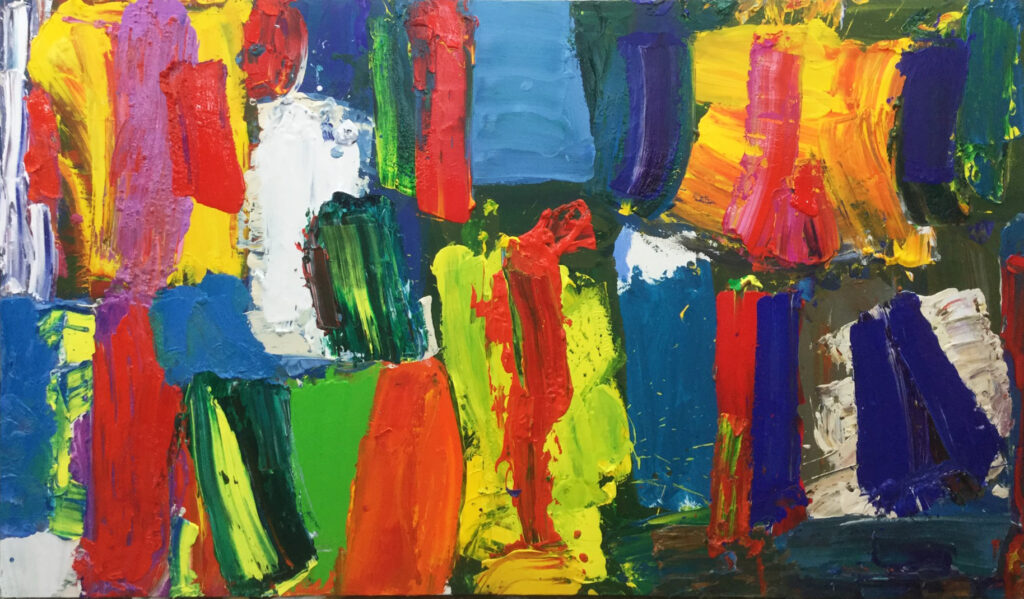
MD: In ‘Principle, Appearance, Style’, Mel Gooding does a fine job of taking the parts of your recorded conversations and piecing together your theory of painting, if we can call it that, in a compact, condensed form- and from that, I get the strong sense that for you, this process of painting authentically- which for you has to mean painting abstractly, I presume- cannot be planned for, anticipated, or have its outcome predicted in any way; it’s all about working the material until the painting, well, materialises. And I myself don’t take issue with any of these beliefs that you hold about painting. It’s just that, as far as the culture of Fine Art now is concerned- or at least, as far as great swathes of it are concerned- your interests, your concerns, are simply old hat; something that has been thoroughly and exhaustively explored. The painting you continue to make: myself, and others, seek it out still, and find freshness and fresh significance in it; but this is not a widely-held view now. Nevertheless, the reason we’re talking today, and the reason why Instantloveland exists, is to try to make the case for a certain kind of continuity between the art being made in the tail-end of the modernist epoch, and what art could be now.
AG: I know the word ‘taste’ is a loaded word, and in some ways, the wrong word; I prefer the term ‘value judgement’. But the point I want to make is this: those whose job it is to consider art, or deal in the currency of judgements on art, have progressively, over a long period of time, lowered the thresholds of their judgements, and over the same period there has been this aggressive promotion of art of questionable quality, of ever-increasing sophistication in developing ways to market the most facile and fatuous kind of work as if it were important and significant. In his time, Picasso was made rich by being encouraged to develop two or three concurrent strands of style in his painting, which were then each targeted at different segments of the art audience in different countries; he could be showing surrealist horror and nightmares in Paris, whilst simultaneously showing neo-classical beauty in New York. And he was complicit in this, obviously, he helped to bring it about, but it was the dealers that turned him into an international art star. And the point is, since then, the galleries have understood how the trick is done: Leo Castelli, who we’re all now familiar with from ‘Painters Painting’, understood the game as well as anyone; and now everyone knows how to play it. You bring out a coffee-table monograph four inches thick, and the art in it has been photographed on the walls and in the grounds of a French chateau, and the presentation is everything. What can you do?
MD: Well, this is the question, what can you do? And in your case, of course, you keep making paintings.
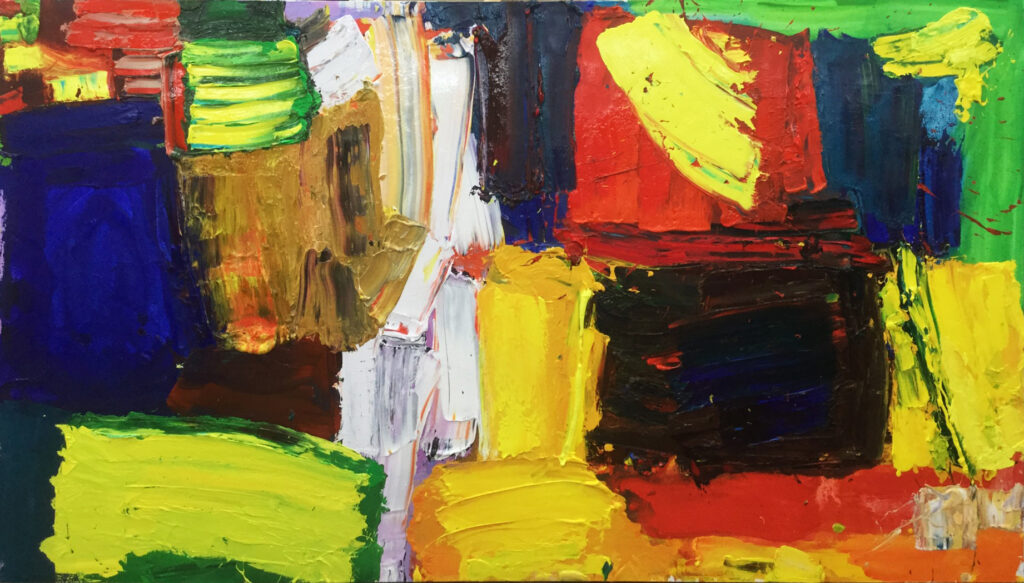
Heron and Greenberg
MD: It interests me that you claim not to give two hoots for anyone else’s opinion regarding the fate of painting; it seems that the dialogue you’re having with painting is not a conversation that you intend to include anyone else in; you’re not worried that there isn’t anyone else listening in…
AG: No, I’m very definitely not worried. John Holland, who contributed regularly to Robin’s Abstract Critical discussion threads, said something in an article he wrote, which I can’t remember word for word, but I can paraphrase: that not since Jasper Johns’ final literalisation of the canvas surface has meaning been looked for in the unmediated visual properties of the painting. Well, fuck that (laughter). Nobody told me, or any of the other painters that I know well; and the idea that one would be self-consciously reflecting before putting a mark on the canvas: that’s not painting at all.
MD: But there are so many terms needing unpacking in a quotation like that: for starters, what exactly is meant here by ‘unmediated visual properties’? I feel it doesn’t go far enough in saying what it means to say to be argued with, really.
AG: Well, what he meant by it was that Jasper Johns had effectively brought painting to an end.
MD: I know that you are particularly vigorous in your response to that kind of sentiment, because I gave voice to certain attitudes- not necessarily believing them, but alluding to them- in the ‘Painters Painting’ dialogue I had with Charley Peters18https://instantloveland.com/wp/2022/12/12/alan-gouk-charley-peters-matt-dennis-fifty-years-of-painters-painting/, and you came out of your corner swinging; but in actual fact, I was very aware, in doing that dialogue, that I was not saying ‘I believe this’, but rather, ‘this is the prevailing view, and has been for a while now.’
I myself don’t happen to believe that Warhol brought a certain kind of painting to a close, any more than Johns did; for a number of reasons, but primarily because he wasn’t really dealing with painting issues in the first place. Warhol speaks more to a certain kind of graphic design than he does to fine art: he brought in some marvellous innovations, and some stylistic points of interest, but they’ve advanced the ‘look’ of graphic design, rather than the resources of painting; it’s easy to forget he was a very successful illustrator and designer before crossing over into fine art. Why do I distinguish between what he made, and painting? Because like you, I think that painting has to do with lack of premeditation, lack of preplanned imagery, and a process with no clear end in sight.
AG: Well, as I’m sure you know, Patrick Heron said that a preconceived design is a dead design. Painting, real painting, is discovered in the process of painting, and not before, and nowhere else. You move towards a design.
MD: Well, alright, but you’re now quoting someone who spent a decade of his artistic life drawing out the whole composition of each painting on the canvas with a felt-tip pen before filling in the lines with colour…

AG: This was one of the paradoxes with Heron: that because he was so obsessed with contradicting the premises of post-painterly abstraction, he ended up with this brittle, strained, unnatural- for him- way of painting. Nobody’s ever acknowledged this, but the two articles on him that I wrote for Artscribe, especially the latter half of the second one, helped him to get away from that. His work opened out again, into a much more natural, improvisatory way of painting.
Because he was such an autodidact, because he’d never really been talked to so directly before, my articles affected him in a way that most people wouldn’t have been; they would have shrugged it off. But he simply wasn’t used to hearing anyone else’s view about him, and so it had quite an impact. Still, unless somebody goes through those articles of mine chapter and verse, no-one’s going to know how they affected Heron; they’ll put the changes in his work down to other factors.
MD: I think of Heron as someone with very developed and painstakingly reasoned views- and yet you are adamant that he was absolutely permeable as regards what you had to say about the work, and changed the course of his work as a result…
AG: His personal grievances with Greenberg had been really getting him down, but he couldn’t leave all that alone. Heron said to me that after one of Greenberg’s visits, Heron’s wife Delia had said of him, Greenberg, that he wasn’t ‘a first-class mind.’19Delia Heron was on to something here: it needs to be understood that Greenberg’s contribution to criticism has been greatly overstated. (In our formative years none of us gave modernism a moment’s thought; it’s only when people talk nonsense about it that it seems necessary to try to define and defend it.) It’s become the convention to think defining modernism has got something to do with Clement Greenberg; well, it hasn’t. Greenberg was a very late entrant into the characterisation of modernism. Everything essential about modernism was laid down around the turn of the twentieth century, after its initial formulation by Baudelaire, with the dichotomy between the embracing of modern life and a contempt for the crowd, the culture-hungry populace of the big cities. But modernism evolved differently in each of the arts, music, painting and sculpture, architecture and literature.
As I said in my article, ‘Greenberg and Modernism’ in AbstractCritical, there are both tough and tender-minded aspects, corresponding to the rational-versus-irrational debate which fuels much of modern philosophy. On the one hand there’s a continuation of the extreme romantic outlook from Wagner to Schoenberg, in which art is a spiritual quest for ‘redemption’ or self-realisation; and on the other, the alternate modernist strategies of the likes of Ortega Y Gasset, T E Hulme, Ezra Pound, and the anti-modern Stravinsky (who in one phase claimed that music was incapable of expressing anything at all), for whom the artist is an artificer donning a series of masks, impersonal personae, the goal being not personal expression, but a distancing and an objectification of experience. (Inversions of these positions take place, so that Schoenberg adopts the artificiality of the twelve-tone system, while Stravinsky’s late work features a quasi-religious ritualising of that same system to convey a religious feeling that it would be churlish to say was synthetic; an atonement for the barbarism of his early ‘Rite of Spring’).
Greenberg was very much on the tough-minded side, as witnessed by his attitude to Rothko and Newman. He balked at the religious element in their pronouncements, and the fuzzy thinking of the ‘Subjects of the Artist’ debate. What Greenberg did was to take the tenets of the International Style in Architecture as defined by Henry Russell Hitchcock and Philip Johnson, and apply them to sculpture, even though no such sculpture then existed.
And the gulf between ‘high art’ and popular culture which exercised the French, (Mallarmé’s priestly elitism on the one hand, and the utilitarian, tongue-in-cheek, populist art of Satie, Cocteau and Les Six on the other) – that opposition had narrowed in America to the point of extinction thanks to the film industry, Hollywood, Tin Pan Alley, etc… the melting pot of values that drew in artists like George Gershwin, Cole Porter, F Scott Fitzgerald, Eric Korngold, and even Stravinsky and Schoenberg; the lure of money compromising everything. Greenberg, coming from a radical left (but anti-Stalinist) background, felt it necessary (with the help of Dwight Macdonald) to write ‘Avant Garde and Kitsch’, probably his most important essay.
One thing that Greenberg got right was the claim that one of the key aspects of modernism was an attempt to maintain the values and aspirations of high art against the tide of middlebrow taste, the horde of semi-educated consumers of culture and the kind of art that fed them, and the journalism of the chic magazines that informed popular taste. He was right to lay emphasis on the insidious capacity of middlebrow values to infect even ‘serious-seeming’ discourse around evaluation of the arts.
What needed to be preserved was depth of engagement with the fundamental resources of the medium, be it painting or music; but first it was necessary to discover what these resources or elements were, hence the urge to simplify… Matisse, it is said, was ‘born to simplify painting’. To paraphrase his credo: when the means have become attenuated, so refined, it is time to return to ‘the source’, that being the raw power of colour. That’s where modernism in painting originates, rather than in the sculptural illustrative complexities of analytical cubism.I think Heron felt that his own abilities and talents were being eclipsed by the inferior abilities of this critic; and whilst I’m not necessarily saying that I agree with that, I do think that’s why Heron felt so aggrieved by the situation with Greenberg for so long.
To approach it from a different angle: when we had the ‘Four Abstract Artists’ exhibition20‘Four Abstract Artists: Abercrombie/Gouk/McLean/Pollock’, Fruitmarket Gallery, Edinburgh 1977, John McLean had already had a solo exhibition up in Edinburgh, at the Talbot Rice Art Centre, and he and Duncan McMillan, director of the Talbot Rice and an old Courtauld colleague, hit upon the idea of a group show, of myself, Fred Pollock, Douglas Abercrombie, and John McLean. Duncan McMillan came down to London, and went round the Stockwell show, and made studio visits, and chose the work. Fine. Next thing we know, Duncan and John between them have asked Clement Greenberg to write the introduction to the catalogue; and I thought right away, I’m not sure that this is a good idea. Anyway, Greenberg wrote the piece and sent it over, and we all got copies of it; and you can check in the five-volume Greenberg collected writings, because it’s there, but it’s a very poor piece of writing; I think he must have been drunk when he wrote it. He said things along the lines of ‘We here in New York haven’t got a very clear picture of the Scots…we see them as having a want of sensuality.’ (Laughter). Where did that come from? Oh, and then ‘We understand the Celticness of the highlanders.’ I think he meant the Catholicism of highlanders; he was trying to air his knowledge of Scottish history, and getting it all wrong. In any case, what the fuck does any of that have to do with anything?
Accusing the Scots of a lack of sensuality; he’d forgotten that Jackson Pollock, David Smith, Robert Motherwell all had Scots/Irish roots. But I suppose the point he was trying to make was, that we were- in artistic terms- all coming out of Kenneth Noland and Morris Louis, and we were amongst the few people that had the sense to see how important their work was; but this was 1977, and you will have gathered by now that all of us, and myself more than anyone, had been trying to get out from under all of that. So I wrote back to Greenberg immediately, enclosing photographs of all of our work, and I said, you’ve got this wrong, we’ve all been influenced far more by the abstract expressionists than by the post-painterly abstractionists. There I am again, the one creating enemies wherever I go (laughter): making an enemy of Duncan McMillan, who was furious that I’d taken it upon myself to write to Greenberg, and making an enemy of Greenberg himself, who wrote back to me saying, you may have a point, but you’re making far too much of it, shut up and let your painting do the talking, that sort of thing.
So, anyway, it came to the show, and Greenberg arrived to give a talk in the lecture theatre at the David Hume Tower, which is one of those steeply-banked seated spaces with the stage down below. Again, like the catalogue essay, the talk he gave was dreadful; even Caro had admitted that Greenberg wasn’t very good as a public speaker. You had to separate the writer from the performer, and concentrate on the former; (in his interview with TJ Clark Greenberg comes across as quite, well, shifty. He hints that he is somehow implicated in or intimately involved with Pollock’s ‘breakthrough’ style, without going any further.) What Greenberg tried to say was, you Scots, you’ve all drifted too far away from the main currents of abstract painting, and the only prospects you have- although he didn’t say this in so many words, of course- is to invest heavily in the sorts of art I like.
The point he went on to make was, art has always congregated around where the centre of commerce is. Once upon a time, it was Florence; then it shifted to Rome; then to Amsterdam; then Paris; and then, of course, it’s New York. And if you wanted to be in the swim as an artist, then you had to go to these places. And Greenberg gave the example of Klee, who went to Paris, met the Delaunays, and in so doing changed his art. And while all of this has the tiniest grain of truth to it, by and large it’s nonsense: the currency of art across all of Europe has always been an international one. Rubens worked at Versailles, then for the Spanish court in Madrid; the Flemish painters were an enormous influence in Venice, and Elsheimer (a German) was influenced by the Venetians, and brought that influence back, from where it is picked up on by Rembrandt and Rubens, and so on and so forth. The Flemish cities, Bruges and Ghent, were controlled by the Spanish Court for much of the seventeenth century. The Van Eycks, Brueghel, and Rubens were all commissioned by the Spanish Royal family. So there never was one dominant commercial centre in Europe especially during all the religious wars. Rome remained a commercial hub long after its time as a creative source. So Greenberg’s thesis doesn’t hold up, but it suits the agenda he was pushing: that New York was the hub. There are of course strong reasons why New York achieved its pre-eminence when it did: because of all the emigrés, Breton, Duchamp, Mondrian, countless others.
This theory of Greenberg’s didn’t go down well: can you imagine what it’s like to tell the Scots that they’re living in a provincial backwater and that the only way out for them is to buy heavily into American art? Douglas Hall, who had been Director of the Scottish National Gallery of Modern Art, wrote a newspaper article the following day, titled ‘Damp Squib at the David Hume Tower.’ The eminent critic, Clement Greenberg…
MD …dies on his arse (laughter).
AG: In the Q&A at the end of Greenberg’s talk, someone in the audience stood up and said, Patrick Heron has written a lot about the cultural imperialism practised by American critics; what do you make of that? And Greenberg did something he often tended to do in public: he came out with a single clipped remark that would cut the whole conversation dead. He said no, you’re right, Patrick hasn’t had enough credit. And that was all.
MD: As I understand it, Patrick’s grievance, the substance of it, was to do with who came first; he felt his garden paintings of the 1950s, where he was laying down fields of vertical strokes, preceded anything similar that the more lyrical of the abstract expressionists were making…
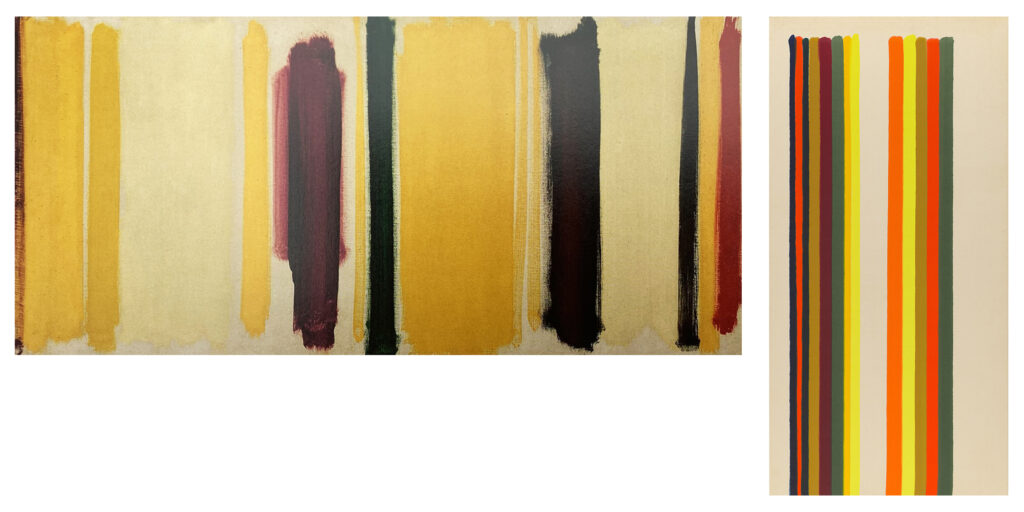
AG: And if you ever asked him- as I did- whether it really mattered who came first, he would blow his top. He would say, that’s not how it goes in the sciences, is it? It matters there (laughter).
MD: I don’t think the comparison stands up, does it? In painting, it’s a question of best rather than first…
AG: Of course originality matters, but not at the expense of painting’s formal and expressive range. Too many of the closely guarded ‘idiomatic innovations’ that obsess the curatorial mind have been grouped around quite reductive and trivial aspects of the art.
In healthier times there is a generosity of spirit, an easy give and take, an open competitive milieu such as Pissarro and Cezanne shared at Pontoise, or Monet and Renoir at La Grenouillere or Braque and Picasso from 1907-10. There are the great moments. But there’s not much generosity of spirit around these days.
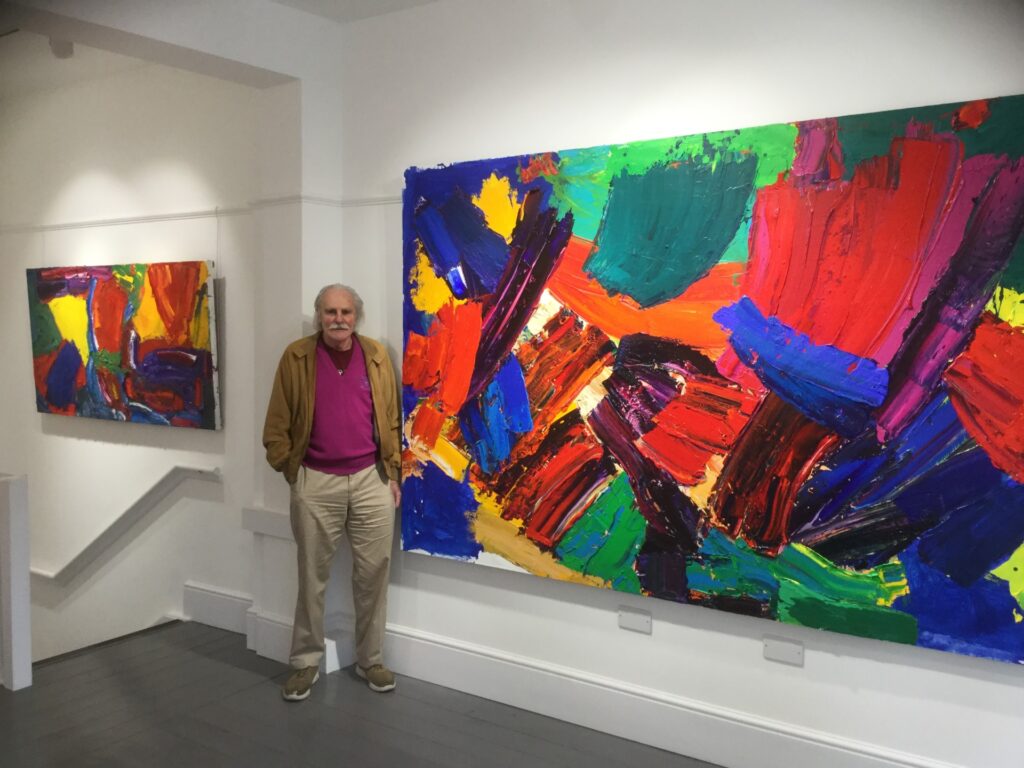
14 thoughts on “Epiphanies and Misdemeanours: Matt Dennis in conversation with Alan Gouk”
Great article!
Great stuff.
Yes! Great, great article!!!
Dear Alan, we seem destined to share our fates. Hundreds of huge paintings, mine in brand new shipping containers. Personally I see it as a huge failure of public taste. However, when you look at the world, it’s not the most serious problem facing us all. Thanks for a most enjoyable few hours. We shared the same artist friends: Heron, Greenberg, Caro, Hoyland. Very lucky to have enjoyed their company. Best, Patrick
I just feel an enormous generosity of spirit, despite the barbs. Alan is giving everything. Very impressive.
Very much enjoyed reading the article with some heavyweights in British painting! A great era of British painting, whatever everyone’s differences were. Fascinating insight.
…And as usual, apart from a glancing mention of Helen Chadwick, not ONE woman painter or sculptor has a place in this chokingly macho ambience. And all those pompous critics, declaiming how and why etc. Even the interviewee thinks he’s the dog’s bollocks, even though, Christ almighty! WHAT a waste of pigment.
Yours, a furious ‘lady’ painter (as you and yours no doubt classify us as.)
I don’t know where this self-identifying ‘lady’ painter has been all these years. She clearly hasn’t taken the trouble to research the ‘ambience’ I come from. This is an interview about my epiphanal moments, not about the full range of my allegiances and colleagues. I did mention my friend Stephenie Bergman, who showed in the first Stockwell show in 1975, Jennifer Durrant, who showed in the second Stockwell show, Kay Saunders, who had a studio at the Depot for many years, and was included in the show I curated for Stoke City Art Gallery in 1990.
Then, in what turned out to be the last Stockwell show in 1979, Mali Morris, another close friend was asked to take part.
Not to mention the sculptors, Katherine Gili, one of the very best sculptors now working, who I’ve written about frequently, and Anne Smart, Hide Skilton, Alexandra Harley, who can be seen in the photo of the Brancaster Chronicle discussion at Greenwich. I’d also point you to the comments section of ‘Fifty Years of Painters Painting’ on Instantloveland.com last year, which talks of Mary Gabriel’s brilliant book ‘Ninth Street Women’, a detailed account of the continuing influence of women painters such as Joan Mitchell, Lee Krasner, Helen Frankenthaler, Grace Hartigan and Elaine De Kooning, major figures all, and who have made the current climate for women painters possible.
Paranoia is one thing, but ignorance is something else.
Greatly informative and hugely entertaining!!
I was a close friend of Grace Hartigan during my Hoffberger scholarship at the Maryland Institute in Baltimore, 1973 to 1975. She lunched with Guston, Tworkov and Dugmore. In 1982 I met Helen Frankenthaler; we became very close friends, talking about painting continuously. After I’d had an operation on my knee, she let me recuperate at her home in Connecticut. We spent evenings gazing across Long Island Sound, watching the lights of the tugboats in the ambiguous gloom. We often discussed Turner. No surprise, then, that her show at Turner Contemporary, Margate, curated by John Elderfield after she had passed, was a shared show with JMW himself. I have been accused of of my share of responsibility for 200 years of lack of response to female painters, because I am male. My parents didn’t ask me to choose my gender.
As a lifelong friend and close neighbour (well, for 50 years, until his death in 2021) of Michael (Mike) Billam, I was delighted to have him mentioned in your interview, and with such respect. Bert Irvin was another friend, along with Brian Fielding and Vic Kuell at Ravensbourne. If you showed in the 1976 Lambeth Festival exhibition in Brixton, I was there too. I think John McLean and Patrick Jones were also there. And I am still here! All best, Philip
Terrific read and explains a lot. Thank you Alan for an amazing experience at St. Martins. David Seaton.
Thanks for including the picture of a 1978 crit where after three months of work, Tony Caro said ‘Turn it upside down’. It was not possible, because the parts of the sculpture came together not as a result of welding, but because of gravity, as in a stone arch. I look like I’m concentrating in the photo because I knew what kind of fight was coming for the future of St Martins (we lost it). Gravity and physical conditions of matter were not really considered key elements in ‘the language of sculpture’; it was all intellectual and visual…
Thanks Alan, and thanks Tim, because all my life after St Martins has followed the path of physicality …
If only there was ‘generosity of spirit’ here in your writing and conversation; it only comes out at the very end. We sense what it was like from the writings of the Impressionists, Fauves, Cubists and Abstract Expressionists …and how! That was present in London when you, McLean, Abercrombie and Pollock exhibited together and continued to paint, closely linked to each other. It continued with Jenny Durrant and Mali Morris, to mention jùst two more.
In New York ‘generosity of spirit’ fares unfavourably by comparison. I think of the antagonism between John Griefen and Joseph Marioni (championed by Michael Fried); compared to the openness of Francine Tint and Jill Nathanson and a few others.
The picture of the wonderful John Panting’s superb ‘VIII’ sculpture woke me up! Thanks.